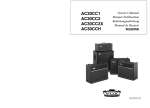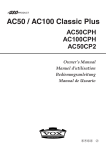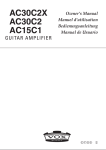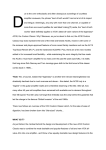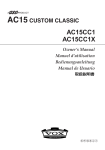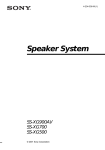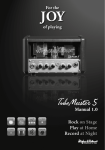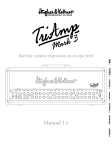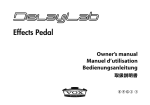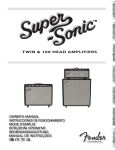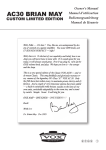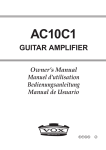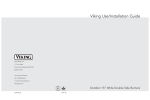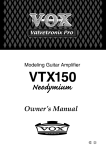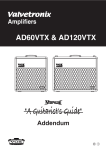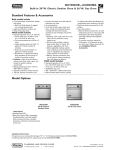Download Vox AC30CC1 User's Manual
Transcript
Owner’s Manual Manuel d’utilisation Bedienungsanleitung Manual de Usuario E F G S J 3 IMPORTANT SAFETY INSTRUCTIONS • • • • • • • • • • • • • • • • • • • • Read these instructions. Keep these instructions. Heed all warnings. Follow all instructions. Do not use this apparatus near water. Mains powered apparatus shall not be exposed to dripping or splashing and that no objects filled with liquids, such as vases, shall be placed on the apparatus. Clean only with dry cloth. Do not block any ventilation openings. Install in accordance with the manufacturer's instructions. Do not install near any heat sources such as radiators, heat registers, stoves, or other apparatus (including amplifiers) that produce heat. Do not defeat the safety purpose of the polarized or groundingtype plug. A polarized plug has two blades with one wider than the other. A grounding type plug has two blades and a third grounding prong. The wide blade or the third prong are provided for your safety. If the provided plug does not fit into your outlet, consult an electrician for replacement of the obsolete outlet. (for U.S.A. and Canada) Protect the power cord from being walked on or pinched particularly at plugs, convenience receptacles, and the point where they exit from the apparatus. Only use attachments/accessories specified by the manufacturer. Unplug this apparatus during lightning storms or when unused for long periods of time. Turning off the power switch does not completely isolate this product from the power line so remove the plug from the socket if not using it for extended periods of time. Install this product near the wall socket and keep the power plug easily accessible. WARNING—This apparatus shall be connected to a mains socket outlet with a protective earthing connection. Refer all servicing to qualified service personnel. Servicing is required when the apparatus has been damaged in any way, such as power-supply cord or plug is damaged, liquid has been spilled or objects have fallen into the apparatus, the apparatus has been exposed to rain or moisture, does not operate normally, or has been dropped. Do not install this equipment on the far position from wall outlet and/or convenience receptacle. Do not install this equipment in a confined space such as a box for the conveyance or similar unit. Use only with the cart, stand, tripod, bracket, or table specified by the manufacturer, or sold with the apparatus. When a cart is used, use caution when moving the cart/apparatus combination to avoid injury from tip-over. The lightning flash with arrowhead symbol within an equilateral triangle, is intended to alert the user to the presence of uninsulated “dangerous voltage” within the product's enclosure that may be of sufficient magnitude to constitute a risk of electric shock to persons. The exclamation point within an equilateral triangle is intended to alert the user to the presence of important operating and maintenance (servicing) instructions in the literature accompanying the product. CE mark for European Harmonized Standards CE mark which is attached to our company’s products of AC mains operated apparatus until December 31, 1996 means it conforms to EMC Directive (89/336/EEC) and CE mark Directive (93/68/EEC). And, CE mark which is attached after January 1, 1997 means it conforms to EMC Directive (89/336/EEC), CE mark Directive (93/ 68/EEC) and Low Voltage Directive (73/23/EEC). Also, CE mark which is attached to our company’s products of Battery operated apparatus means it conforms to EMC Directive (89/336/EEC) and CE mark Directive (93/68/EEC). * Company names, product names, and names of formats etc. are the trademarks or registered trademarks of their respective owners. 2 INTRODUCTION Congratulations on your purchase of an AC30 Custom Classic. This amp is the culmination of over 45 years of manufacturing expertise and high quality, guitar amplifier design. We have taken the best AC30 designs and added a number of useful and interesting features to give you the most tonally flexible AC30 to date! We’re confident you will find these improvements extremely useful and that your new amplifier will give you many hours of tonal pleasure. Your AC30 is equipped with a number of modern features and conveniences like blend-able channels, a true bypass FX loop and master volume, to name a few. Please read this manual carefully so that you can familiarize yourself with them. In order to ensure that this new AC30 meets exacting standards for tone, quality and reliability, it has been built entirely in our vertically-integrated manufacturing facility, a facility capable of many processes not usually found in guitar amplifier factories. We design and manufacture our own transformers, speakers (except for the venerable Vox “Blue” made in the UK by Celestion), cabinets (all birch construction) and electronics. What this means to you is that the sound of your new AC30 is second to none. The birth of an amp… The AC30 is one of the most quintessential guitar amplifiers of all time. The legendary combo amp made its debut in 1959 and its unique tone has helped define the sound of modern guitar for more than 45 years. Although the VOX brand has been owned by numerous companies, and even though each of them has made some changes to the AC30, the amp itself has remained basically unchanged since 1965. This in itself is a glowing tribute to the original product designed by Dick Denny when VOX was part of Jennings Musical Industries. There are very few guitar amplifiers still selling today that have not undergone massive changes in their basic design format. In fact, most vintage style amplifiers available today disappeared from sale for many years and have only just been re-released in a re-issue format; the basic AC30 has always been available. As stated, every new owner of the brand made minor changes to the construction or electronic design. While some were arguably good changes, some were not so good, but the basic format of the amp remained the same. What makes the AC30 so revered? Its unique and warm tone, its player friendly “feel” and its very simplistic circuit design. Even with the simple “what you see is what you get” control format, the AC30 found favor with artists since its inception. VOX basically owned the “British invasion” of the 1960s and the AC30 continues to be used by a diverse group of artists that span a wide range of musical styles. The one drawback to this wonderful amp is that, though it has features and facilities that were well founded and useful for bands in the late ‘50s, in this day and age these same features are regarded as “quirky,” at best! For instance: there are three channels with two inputs each. Namely TOP BOOST, NORMAL, and VIB/TREM. By far the most commonly used is the TOP BOOST channel, as this has the most pleasing and varied tonal spectrum, especially for today’s players. Coming second in use (but a long, long way behind) is the NORMAL channel. Although this channel only features a volume control and nothing else, when coupled with a certain treble boost pedal, this setup is an integral part of Brian May’s killer tone. Thirdly the VIB/TREM channel finds very, very little use these days, except for accessing the VIB/TREM circuit itself. The VIB/TREM channel, tonally, is very poor in relation to the other channels and rarely gets used for its sonic performance – yet it has more electronic circuitry than the rest of the amp put together! 3 When the AC30 was originally designed, the above features were of great benefit for that time. It fitted in with the music styles of the day, and, probably more importantly, only one amplifier was needed for guitar (or two), bass and vocals; they could all be plugged into a single AC30. In those days money for equipment was very scarce, particularly in the UK, and high volume levels certainly weren’t allowed in the popular venues. Basically the VOX amps, and most others, were intended as general-purpose amps. Ironically they also sounded fantastic when used purely as guitar amps, which is why they have endured to this day. Another drawback, although by happenstance a very nice drawback (!), is the use in the AC30 of two Celestion Alnico loudspeakers. They are some of the nicest sounding speakers that have ever been made, even though they date back to the early ‘60s. These speakers are also, without a doubt, some of the loudest and most efficient ever made. This, coupled with the unique VOX circuit, makes the AC30 a very, very loud amplifier, especially when “cranked” to produce the overdrive levels used today. When fully cranked, the AC30’s “loudness” makes this non-master-volume amp simply too much for many guitar players to use practically. In 1992, a new version of the AC30 Top Boost was born. This was to be as close sonically as the original, but for many good reasons built to more modern day standards. This amplifier has been more than successful in re-establishing VOX as a premier amplifier manufacturer again. In 2004, because of a number of factors, we decided that the best way of taking VOX forward into the 21st century was to look at how we could make the AC30 more suitable for both present day and future amplifier purchasers; not an easy job considering its long standing history! Over the last few years, market research by many guitar amp companies has always come back with the market requirements of “Vintage Tone & Modern Features.” Well, we certainly had the Vintage Tone, but not the Modern Features! So, what Modern Features could be added to the AC30 without any sacrifice to the vintage tone? The basic list came down to reverb, FX loop and a suitable way of adding an output volume control that worked well with the tone of the amp, namely, a master volume. The last bit was easy; we had already done it on the AC15TB amp that came out in the mid ‘90s. The rest was a bit harder. Anything that was added had to definitely add great benefit to the amp, BUT not take anything away from it or affect the AC30’s signature sound and feel. By chance we had already tested the water for new features when we introduced the above mentioned AC15TB equipped with reverb, global tremolo and master volume. The broad acceptance of those additional features in the AC15TB led to the limited-edition AC30HW. The overwhelming success of the AC30HW (even with die hard vintage AC30 users) gave us the indication that we were on the right track for the redesign of regular production AC30 amps. After much head scratching, VOX R&D UK came up with the design of the new amplifier which you have in front of you. This not only included the required Top Boost channel with reverb, FX loop, global tremolo and master volume, but a whole host of “boutique” features as well. When the first prototype was presented to a panel of guitar players and market specialists, the prototype was acclaimed as possibly being the most perfect AC30 ever. Our new AC30 has the tone and feel of a vintage AC30 with a host of features that make it more practical for today’s guitarists, plus a number of subtle new boutique features that have never been incorporated into a production amplifier! Thusly, we have named this series as AC30 Custom Classic. 4 In order to satisfy the demands of a variety of playing situations, we decided to offer the Custom Classic in a number of different configurations. While the amplifier chassis specifications are identical, different speaker options are available as follows: AC30CC1: 1x12" combo with a custom voiced VOX NeoDog speaker AC30CC2: 2x12" combo with a pair of custom designed GSH12-30 speakers which add a top end mellowness and smooth bass response AC30CC2X: 2x12" combo with the world revered Celestion “Blue” 15 watt AlNiCo speakers as used in the original AC30 combo AC30CCH: Head Three speaker cabinets are available for use with the AC30CCH or as extension cabinets for the combos. They are: V212BN: 2x12" cabinet with two GSH 12-30 speakers V212BNX: 2x12" cabinet with Celestion “Blue” AlNiCo speakers V412BN/BL: 4x12" cabinet with two GSH 12-30 speakers 5 FRONT PANEL LAYOUT 1 2 3 4 5 6 7 8 9 10 11 12 13 14 1) Inputs Top Boost: Plugging your guitar into this input will route your signal through the Top Boost channel. Normal: Plugging your guitar into this input will route your signal through the Normal channel. 2) Input Link switch: This is where you can link or “blend” the Normal and Top Boost channels. This switch works in conjunction with, and is dependent on which of the inputs is used. Here are the options you have: When you plug into the upper Top Boost input and the switch is in the “up” position, you will only access the Top Boost channel. When you plug into the lower Normal input and the switch is in the “up” position, you will only access the Normal channel. To blend the channels, simply plug into the upper Top Boost input and move the switch to the “down” position and you can now blend the Top Boost and Normal channels. 3) Normal Volume: This determines the sensitivity of the preamp section in the Normal channel. Depending on where this is set, you can either blend in more gain by turning it clockwise or you can set it lower for a cleaner sound. This works in conjunction with the Master Volume meaning that if you keep this volume lower and the Master higher, you will get a cleaner sound and conversely, if you keep this higher and the Master lower you will get more gain and distortion. 4) Brilliance switch: This switch engages the Brilliance function on the Normal channel and will add more top end brightness. Engaging the Brilliance switch will make the Normal channel into one from a vintage “Treble” AC30. 5) Top Boost Volume: This determines the sensitivity of the preamp section in the Top Boost channel. Depending on where this is set, you can either blend in more gain by turning it clockwise or you can set it lower for a cleaner, “chimey” sound. This works directly with the Master Volume meaning that if you keep this volume lower and the Master higher, you will get a cleaner sound and conversely, if you keep this higher and the Master lower you will get more gain. 6) Treble: This controls the treble (high) frequencies in your sound — from soft and round when turned down (counterclockwise) to bright and cutting when cranked (clockwise) and all points in-between. 7) Standard/Custom Switch Standard: When this is selected the EQ (Treble and Bass) becomes very interactive and acts like a standard AC30. As you increase the Treble or Bass, the mids are decreased and conversely, as you decrease Treble or Bass, mids are increased. Custom: When this is selected the EQ becomes less interactive like an AC30 Hand Wired or an AC15TB. 6 8) Bass: This controls the bass (low) frequencies in your sound — from warm and light when turned down (counterclockwise) to dark and heavy when turned up full (clockwise) and all points in-between. 9) Reverb Section: This section allows you to control the Reverb for both channels by adjusting the Tone and Mix controls as well as the Dwell switch. You can remotely switch the reverb On or Off with the supplied footswitch. Tone: This controls the high and low frequencies of the reverb. You can add brightness to the reverb by turning it clockwise or add darkness by turning it counterclockwise. Experiment with this control to see which setting(s) work best for you. Dwell mini toggle: This controls the amount of drive that’s going to into the reverb. Low Drive: Use this when you are using a higher gain sound High Drive: Use this when you are using a lower gain, “cleaner” sound. Mix: This controls the mix (amount) of reverb in your sound. Turning this knob fully clockwise will give you a wet, saturated sound while counterclockwise will give you a drier sound. 10) Tremolo Section: This section allows you to control the Tremolo for both channels on this amplifier by adjusting the Speed and Depth. You can remotely switch the reverb On or Off with the supplied footswitch. Speed: As you might have guessed, this controls the speed of the built-in Tremolo. Depth: This controls the depth (intensity) of the built-in tremolo. 11) Cut: This circuit is placed in the power amp as opposed to the preamp section like the Treble and Bass controls. What this does is the opposite of what you may think. Turning it clockwise will decrease the higher frequencies and turning it counterclockwise adds higher frequencies. 12) Master Volume: This controls the overall (Master) volume of your amplifier. Cleaner sounds can be achieved by lowering the Normal or Top Boost volumes and raising the Master. Setting the Master lower and the Normal and Top Boost volumes higher will give you a fatter, more distorted tone. As with all the controls of this amplifier, please experiment with different configurations to find the tones that fit your playing style. 13) Standby Switch: This switch allows the amplifier to attain the correct working temperature before applying the H.T. supply. Before connecting the amplifier to the Mains supply, ensure the Power and Standby switches are in the off position. Turn on the Power switch first and then wait 2–3 minutes before turning on the Standby switch. Doing this each time you play helps prolong tube life. The Standby switch is also very useful for playing live as it allows you to keep the valves at a functional temperature between sets. 14) Power Switch: This is the ON/OFF switch for the power to the amplifier. Please ensure the amplifier is switched off and unplugged before being moved. 7 REAR PANEL LAYOUT 1 2 3 4 5 6 7 8 9 1) Loudspeaker Output Jacks: This is where you can hook up an extension or external speaker cabinet(s) if desired. Note! Hooking up a cabinet through the External jack will mute (disconnect) the internal speakers! Extension: This speaker jack runs parallel with the internal speakers which are wired for 16 Ohms. The extension cabinet must be 16 Ohms. External: This speaker jack will mute (disconnect) the internal speakers and you can hook up either a 16 Ohm or 8 Ohm cabinet. Be sure to set the Output Select switch accordingly. NOTE! AC30CCH: You’ll notice the rear panel speaker jacks are labeled the same as the combos even though the head does not have internal speakers! Both jacks (External and Extension) are parallel so run cabinets as you normally would. One 16 ohm cabinet into either jack, two 16 ohm cabinets into both jacks or one 8 ohm cabinet into either jack with the impedance select switch set accordingly. See below for hook up options. WARNING! To ensure that your system works correctly, you must observe the following points. a) Don’t use an external speaker whose impedance is other than 8 ohms. b) Don’t connect a speaker whose rated input capacity is less than 30 watts. The speaker may be destroyed if you ignore this caution — not recommended! c) You must use a speaker cable to connect an external speaker. Don’t use a shielded cable like the one you use to connect a guitar to an amp. d) You must turn off the power before connecting the cable. Connecting the cable while the power is turned on may damage your amp. Note! It is recommended that all audio cables, with the exception of the speaker lead, used to connect to the AC30 Custom Classic are of a high quality, screened type. These should not exceed 10 metres in length. Always use a non-screened Vox approved speaker lead with the AC30 Amplifier and extension cabinets. 2) Output (O/P) Select COMBOS 16 Ohm: Combos allow for the following configurations: 1) Set it to this if you use the internal speakers only. 2) Set it to this if you connect a cabinet through the External jack and the impedance is 16 ohms. HEAD 16 Ohm: Head allows for the following configuration: 1) Set it to this if you use one 16 ohm cabinet. Either jack can be used. COMBOS 8 Ohm: Combos allow for the following configurations: 1) Set it to this if you connect an extension cabinet through the Extension jack. You’ll be running the internal and external speakers in parallel. The impedance of the extension cabinet must be 16 Ohms. 2) Set it to this if you connect an external 8 ohm cabinet through the External jack. HEAD 8 Ohm: Head allows for the following configurations: 1) Set it to this if you connect two 16 ohm cabinets. 2) Set it to this if you connect one 8 ohm cabinet. 8 3) Output Bias: This allows for specific biasing of your amplifier. 82 Warm: This setting will run your amplifier at about 22 watts clean (before clipping) which is similar to an early 4 input AC30. What this means to you is that you’ll have less clean headroom and get a warmer sound at lower volume levels plus your tube life will be prolonged. 50 Hot: This setting will run your amplifier at about 33 watts clean (before clipping) which is similar to a standard 6 input AC30. The tubes will be running hotter but you will have more clean headroom. 4) Smoothing: This changes the values of the filter caps within your amplifier. 22µf Vintage: This setting is similar to vintage AC30s where your sound will be more open and loose. You may experience slightly more “hum” when the amp is idling. 44µf Modern: As the name would suggest, this is going to act more closely to a modern AC30 such as the hand wired AC30HW. Your sound will be tighter and the amp will run quieter. 5) FX Loop: This is where you can hook up external processors such as rack or stompbox effects. Level -10/+4 dB: If you run a rack processor through the FX Loop set the Level switch to +4. If you run a stomp box effect set the level to -10. NOTE: There is no rule set in stone for these levels. Please try both settings and use what works best for you as every playing and effect situation will be different. FX Send: Think of this as the “output” of the FX loop and will be connected to the input of your effect(s). FX Return: Think of this as the “input” of the effects loop and will be connected to the output of your effect(s). NOTE: Be sure to use shielded guitar cables only! NEVER use unshielded speaker cables. FX Loop Bypass ON/OFF : This is a true bypass effects loop which means if this is set in the “off” position, absolutely none of your original signal will be running through it until it’s switched “on”. 6) Footswitch jack: This is where you connect the supplied VOX footswitch so you can turn the Reverb and Tremolo on and off. 7) HT Fuse: This fuse protects your amp should a fault occur with the power. The most common reason for this fuse to blow is when an output tube becomes faulty. The correct vale of the HT fuse is located on the rear panel of the amplifier and should only be replaced with one of the same value. 8) Mains Input: This is where the supplied, detachable Mains (power) cord is connected. The specific mains input voltage rating that your amplifier needs to run at is located on the rear panel of your amplifier. Before making any connections or powering up the amplifier, make sure the correct voltage is set. If you have any doubt, refer to your local VOX dealer. 9) Mains Fuse: This fuse provides an overall safety protection in the event your amplifier develops and electrical fault. The correct value of the fuse is located on the rear panel of your amplifier and should only be replaced with one of the same value. 9 SPECIFICATION AC30CC1 30Watt, 1x12 Combo, Celestion Neo-dog speaker • Dimensions (W x H x D): 610 x 540 x 265 mm (24 x 21.25 x 10.4 inches) • Weight: 24.5kg (54 lbs.) • Output Power: 30 Watts RMS into 16 Ohms AC30CC2 30Watt, 2x12 Combo, Wharfdale speakers • Dimensions (W x H x D): 705 x 540 x 265 mm (27.75 x 21.25 x 10.4 inches) • Weight: 32kg (70.5 lbs.) • Output Power: 30 Watts RMS into 16 Ohms AC30CC2X 30Watt, 2x12 Combo, Clesestion Alnico speakers • Dimensions (W x H x D): 705 x 540 x 265 mm (27.75 x 21.25 x 10.4 inches) • Weight: 32kg (70.5 lbs.) • Output Power: 30 Watts RMS into 16 Ohms AC30CCH 30Watt, Amplifer head • Dimensions (W x H x D): • Weight: • Output Power: 615 x 275 x 265 mm (24.2 x 10.83 x 10.4 inches) 19kg (41.9 lbs.) 30 Watts RMS into 16 Ohms * Specifications are subject to change without notice. ©2004 VOX AMPLIFICATION LTD. 10 11 INFORMATIONS IMPORTANTES DE SECURITE • • • • • • • • • • • • • • • • • • • • Lisez attentivement ces instructions. Veuillez conserver ces instructions. Observez tous les avertissements. Suivez toutes les consignes à la lettre. N’utilisez jamais cet appareil dans un endroit humide ni à proximité d’eau. L’appareil alimenté par courant électrique ne peut pas être exposé à des éclaboussures; évite en outre de placer des récipients contenant des liquides, comme un vase (ou un verre de bière), sur l’appareil. Nettoyez uniquement l’appareil avec un chiffon doux et sec. Ne bloquez jamais les orifices de ventilation de l’appareil et installez-le toujours conformément aux instructions du fabricant. N’installez jamais l’appareil à proximité d’une source de chaleur, telle que des radiateurs, poêles ou tout autre dispositif (y compris des amplificateurs) générant de la chaleur. N’essayez jamais de contourner le dispositif de sécurité d’une prise de type polarisée ou d’une prise de terre. Une prise dite polarisée dispose de deux broches, dont l’une est plus large que l’autre. Une prise de terre comporte trois broches, dont une de mise à la terre. Cette broche plus large ou broche de mise à la terre vise à assurer votre sécurité. Si la fiche du cordon d’alimentation ne correspond pas au type de prise de courant de votre région, faites remplacer la prise obsolète par un électricien qualifié (pour les Etats-Unis et le Canada). Placez toujours le cordon d’alimentation de sorte qu’on ne risque pas de marcher dessus ni de le pincer. Cette précaution vise tout spécialement la fiche du cordon et sa sortie de l’appareil. Utilisez exclusivement les fixations/accessoires préconisés par le fabricant. S’il y a risque d’orage ou que vous ne comptez pas utiliser l’appareil pendant une période prolongée, débranchez-le du secteur. La mise sur OFF de l’interrupteur d’alimentation n’isole pas totalement ce produit de la ligne secteur; aussi, retirez la fiche de la prise s’il doit rester inutilisé pendant une période prolongée. Installez ce produit près de la prise électrique murale et gardez un accès facile à la prise électrique et au cordon d’alimentation. ATTENTION: Cet appareil doit absolument être connecté à une prise électrique reliée à la terre. Confiez tout travail de réparation uniquement à un S.A.V. qualifié. Faites appel au S.A.V. si l’appareil a subi tout endommagement, comme par exemple si sa fiche secteur ou son cordon d’alimentation sont endommagés, si de l’eau ou des objets ont pénétré à l’intérieur de l’appareil, si celui-ci a été exposé à la pluie ou à la moisissure, s’il est tombé ou présente tout signe de dysfonctionnement. N’utilisez jamais d’allonge trop longue avec cet appareil et ne l’alimentez jamais via les prises secteur équipant d’autres dispositifs. N’installez jamais cet appareil dans un endroit confiné comme une caisse de transport ou tout autre récipient similaire. Utilisez l’appareil uniquement avec le chariot, stand, trépied, fixation ou table spécifiés par le fabricant ou fourni avec l’appareil. Si vous avez placé l’appareil sur un chariot, soyez très prudent quand vous déplacez le chariot, afin d’éviter une chute et des blessures. L’éclair dans le triangle est un symbole destiné à attirer l’attention de l’utilisateur sur la présence de parties non isolées et de “tension dangereuse” à l’intérieur de l’appareil, qui posent des risques d’électrocution pour l’utilisateur. Le point d’exclamation dans un triangle est un symbole destiné à attirer l’attention de l’utilisateur sur des sections de ce manuel contenant des informations importantes, liées à l’utilisation et à l’entretien de ce produit. Marque CE pour les normes européennes harmonisées La marque CE apposée sur tous les produits de notre firme fonctionnant sur secteur jusqu’au 31 décembre 1996 signifie que ces appareils répondent à la Directive EMC (89/336/CEE) et à la Directive concernant la marque CE (93/68/CEE). La marque CE apposée après le 1 janvier 1997 signifie que ces appareils sont conformes à la Directive EMC (89/336/CEE), à la Directive concernant la marque CE (93/68/CEE) ainsi qu’à la Directive Basse Tension (73/23/CEE). La marque CE apposée sur tous les produits de notre firme fonctionnant sur piles signifie que ces appareils répondent à la Directive EMC (89/336/CEE) et à la Directive concernant la marque CE (93/68/CEE). * Les noms de sociétés, noms de produits et noms de formats, etc. dans ce manuel sont des marques de fabrique ou des mar-ques déposées de leurs propriétaires respectifs. 12 INTRODUCTION Félicitation pour votre acquisition d’un AC30 Custom Classic. Cet amplificateur représente la somme de plus de 45 ans de savoir-faire en matière de fabrication d’amplis de guitare de haute qualité. Nous avons choisi les AC30 les mieux conçus et ajouté un certain nombre de caractéristiques aussi utiles qu’intéressantes pour vous offrir l’AC30 aux sonorités les plus polyvalentes à l’heure actuelle! Nous sommes certains que vous apprécierez ces améliorations d’une utilité indéniable et que votre nouvel amplificateur sera le compagnon d’intenses moments de plaisir. Votre AC30 est doté de caractéristiques actualisées telles que canaux combinables, une véritable boucle d’effet (contournable) ou une commande de volume Master pour n’en citer que quelques unes. Veuillez lire ce mode d’emploi attentivement afin de vous familiariser avec votre ampli. Pour que ce nouvel AC30 réponde aux normes de qualité, fiabilité et sonorité les plus exigeantes, il a été entièrement fabriqué dans notre usine à intégration verticale, capable d’appliquer des procédés peu courants dans l’industrie des amplificateurs de guitare. Nous concevons et construisons nos propres transformateurs, nos haut-parleurs (à l’exception des vénérables Vox “Blue” fabriqués au Royaume Uni par Celestion), nos enceintes (toutes en bouleau) et notre électronique. Cette approche vous permet de bénéficier d’un AC30 d’une sonorité à nulle autre égale. Naissance d’un ampli… L’AC30 est un des plus grands amplis de guitare de tous les temps. Ce légendaire ampli combo a fait ses débuts en 1959 et sa sonorité, unique en son genre, détermine le son de guitare depuis plus de 45 ans. Bien que la marque VOX soit passée entre de nombreuses mains et que l’AC30 ait fait l’objet de plusieurs remaniements, l’ampli est resté fondamentalement le même depuis 1965. C’est un hommage en soi au produit original conçu par Dick Denny quand VOX était détenu par Jennings Musical Industries. Les amplificateurs de guitare qui n’ont pas été modifiés en profondeur depuis leur arrivée sur le marché sont extrêmement rares. En fait, la plupart des amplis de style vintage disponibles aujourd’hui ont disparu du marché durant des années et viennent seulement d’être réintroduits dans un format réédité; l’AC30 de base a toujours été disponible. Les détenteurs successifs de la marques n’ont effectué que des changements mineurs à la conception ou à l’électronique. Certaines de ces modifications étaient meilleures que d’autres mais elles n’ont pas altéré l’essence même de l’ampli. Qu’est-ce qui explique le succès de l’AC30? Sa sonorité unique et chaleureuse, un “feeling” stimulant et une circuiterie extrêmement simple. En dépit de commandes simples au possible, l’AC30 connaît un succès qui ne se dément pas depuis son apparition. VOX possédait pratiquement la “British invasion” des années 1960 et l’AC30 continue à être utilisé par les artistes les plus divers, couvrant une palette de genre musicaux extrêmement large. Ce superbe ampli n’avait qu’un seul défaut: certaines caractéristiques, bien utiles à la fin des années ‘50, sont à l’heure actuelle, au mieux, “excentriques”! Par exemple: il y a trois canaux ayant deux entrées chacun, TOP BOOST, NORMAL et VIB/TREM. De loin le plus utilisé, le canal TOP BOOST propose le spectre tonal le plus varié et le plus recherché, particulièrement par les guitaristes actuels. Vient ensuite (mais loin derrière) le canal NORMAL. Bien que ce canal n’ait qu’une commande de volume et rien d’autre, il est, en combinaison avec une certaine pédale accentuant l’aigu, à l’origine du son immortel de Brian May. Le canal VIB/TREM ne fait que très peu d’adeptes si ce n’est pour accéder au circuit VIB/TREM même. Comparé aux autres, le canal VIB/TREM est très pauvre sur le plan tonal et donc rarement utilisé pour sa sonorité, et pourtant, il a plus d’électronique que tout le reste de l’ampli! 13 Lors de la conception de l’AC30, ces caractéristiques étaient idéales pour l’époque. L’ampli correspondait aux styles de musique et, ce qui était peut-être plus important encore, il permettait de n’utiliser qu’un seul ampli (voire deux) pour la guitare, la basse et le chant; un seul AC30 suffisait. A l’époque, il y avait très peu d’argent pour le matériel, surtout au Royaume Uni et les volumes élevés étaient interdits dans les salles populaires. En fait, les amplis VOX, et la plupart des autres, étaient conçus pour servir d’amplis universels. Ils avaient aussi un son fantastique quand ils étaient utilisés purement en tant qu’amplis de guitare, ce qui explique leur longévité. Un autre défaut mais bienvenu celui-là (!) est l’intégration dans l’AC30 de deux haut-parleurs Celestion Alnico. Ils font partie des plus meilleurs haut-parleurs jamais créés bien qu’ils datent du début des années‘60. Ces haut-parleurs comptent aussi indubitablement parmi les plus forts et les plus efficaces. Combinés au circuit VOX unique en son genre, ils font de l’AC30 un amplificateur très, très fort, particulièrement lorsqu’il est “poussé” pour produire les niveaux de saturation recherchés actuellement. Quand il est poussé à fond, le niveau de l’AC30 rend cet ampli, dépourvu de commande de volume maître, pratiquement impossible à utiliser pour de nombreux guitaristes. En 1992, une nouvelle version de l’AC30 Top Boost voit le jour. Du point de vue sonore, il devait être proche de l’original mais pour de nombreuses bonnes raisons, il répondait aussi à des normes de conception actualisées. Cet ampli a plus que réussi son pari et a rétabli la réputation de VOX en tant que fabricant d’amplificateur de grande classe. En 2004, nous avons décidé, pour diverses raisons, que la meilleure façon d’emmener VOX dans le 21ème siècle consistait à actualiser l’AC30 et à le préparer pour l’avenir… pas simple au vu de sa longue histoire! Ces dernières années, des études de marché faites par diverses firmes d’amplis de guitare ont démontré que le couple “son vintage & caractéristiques modernes” est payante. Nous avions certainement le son vintage mais pas les caractéristiques modernes! Quelles caractéristiques actualisées pouvions-nous donc ajouter à l’AC30 sans sacrifier sa sonorité vintage? Les essentiels comprennent la réverbération, la boucle d’effet et un moyen d’ajouter une commande de niveau de sortie étudiée pour la sonorité de l’ampli, à savoir une commande de volume master. Cette commande ne posait pas de problème: nous l’avions déjà sur l’AC15TB sorti au milieu des années ‘90. Le reste était un peu plus dur. Toute nouveauté devait réellement améliorer l’ampli MAIS sans retirer quoi que ce soit et sans affecter la sonorité propre de l’AC30. Heureusement, nous avions déjà abordé et testé ces caractéristiques lors de l’introduction de l’AC15TB, doté de réverbération, trémolo global et volume master. L’excellent accueil réservé à ces nouveautés sur l’AC15TB nous a conduit à sortir l’AC30HW en édition limitée. L’incroyable succès de l’AC30HW (même auprès de fanatiques de l’AC30 vintage) ont conforté notre projet de revoir la conception de tous les amplis AC30. Après de nombreuses sessions de brainstorming, VOX R&D UK a sorti l’amplificateur que vous avez devant vous. Outre l’impératif canal Top Boost avec réverb, la boucle d’effets, le trémolo global et le volume master, il propose aussi tout un éventail de caractéristiques “boutique”. Lorsque ce prototype a été présenté à un panel de guitaristes et spécialistes du marché, ces derniers l’ont proclamé l’AC30 peut-être le plus parfait jamais créé. Le nouvel AC30 a la sonorité et le feeling d’un AC30 doté en plus d’une palette de fonctions qui en facilitent l’utilisation pour les guitaristes actuels ainsi que des caractéristiques “boutique” qu’aucun amplificateur de production n’a jamais eues! Nous avons donc baptisé cette série “AC30 Custom Classic”. 14 Pour répondre aux exigences de divers contextes de jeu, nous avons décidé de décliner le Custom Classic en plusieurs modèles. Alors que les spécifications de l’amplificateur restent identiques, vous avez le choix entre plusieurs options de haut-parleurs: AC30CC1: Combo 1x12" avec haut-parleur customisé VOX NeoDog AC30CC2: Combo 2x12" avec une paire de haut-parleurs customisés GSH12-30 arrondissant l’aigu et offrant une réponse régulière dans le grave AC30CC2X: Combo 2x12" avec les célébrissimes haut-parleurs Celestion “Blue” 15W AlNiCo utilisés dans le combo AC30 original AC30CCH: Tête Des enceintes supplémentaires sont disponibles pour un usage avec l’AC30CCH ou comme extensions pour les combos. Vous avez le choix entre trois modèles: V212BN: Enceinte 2x12" avec deux haut-parleurs GSH 12-30 V212BNX: Enceinte 2x12" avec haut-parleurs Celestion “Blue” AlNiCo V412BN/BL: Enceinte 4x12" avec deux haut-parleurs GSH 12-30 15 FACE AVANT 1 2 3 4 5 6 7 8 9 10 11 12 13 14 1) Entrées Top Boost: Branchez votre guitare à cette entrée pour envoyer son signal au canal Top Boost. Normal: Branchez votre guitare à cette entrée pour envoyer son signal au canal Normal. 2) Commutateur Input Link: C’est ici que vous pouvez lier ou “mélanger” les canaux Normal et Top Boost. Ce commutateur fonctionne en symbiose avec les entrées et est tributaire de l’entrée utilisée. Vous avez le choix entre les possibilités suivantes: Si vous branchez la guitare à l’entrée Top Boost avec le commutateur relevé, vous n’avez accès qu’au canal Top Boost. Si vous branchez la guitare à l’entrée Normal avec le commutateur relevé, vous n’avez accès qu’au canal Normal. Pour mélanger les canaux, branchez simplement la guitare à l’entrée Top Boost et abaissez le commutateur: vous pouvez alors mélanger les canaux Top Boost et Normal. 3) Normal Volume: Détermine la sensibilité de la section préampli pour le canal Normal. Selon son réglage, vous pouvez augmenter le niveau en tournant la commande vers la droite ou le diminuer pour obtenir un son plus clair. Cette commande est liée à la commande Master Volume: si vous choisissez un niveau assez bas pour cette commande et réglez la commande Master sur un niveau plus élevé, vous obtenez un son clair. Inversement, si vous choisissez un niveau élevé ici et un niveau Master plus bas, vous avez plus de distorsion. 4) Commutateur Brilliance: Ce commutateur active la fonction Brilliance pour le canal Normal et rend l’aigu plus éclatant. Activez le commutateur Brilliance pour transformer le canal Normal en AC30 “Treble” vintage. 5) Top Boost Volume: Détermine la sensibilité de la section préampli pour le canal Top Boost.Selon son réglage, vous pouvez augmenter le niveau en tournant la commande vers la droite ou le diminuer pour obtenir un son plus clair, plus cristallin. Cette commande est liée à la commande Master Volume: si vous choisissez un niveau assez bas ici et réglez la commande Master sur un niveau plus élevé, vous obtenez un son clair. Inversement, si vous choisissez un niveau élevé ici et un niveau Master plus bas, vous avez plus de distorsion. 6) Treble: Contrôle les hautes fréquences (l’aigu) du son; vous pouvez aller d’un son doux et rond (à gauche toute) à un son coupant et éclatant (à fond à droite). 7) Commutateur Standard/Custom Standard: Avec cette option, l’égalisation (Treble et Bass) devient très interactive et agit comme sur un AC30 standard. Plus vous augmentez le réglage Treble ou Bass, plus le médium diminue; inversement, plus vous diminuez le réglage Treble ou Bass, plus le médium augmente. Custom: Avec cette option, l’égalisation est moins interactive et agit comme sur un AC30 Hand Wired ou un AC15TB. 16 8) Bass: Contrôle les basses fréquences (le grave) du son; vous pouvez aller d’un son chaud et léger (à gauche toute) à un son heavy et sombre (à fond à droite). 9) Section Reverb: Cette section vous permet de contrôler la réverbération des deux canaux avec les commandes Tone et Mix ainsi que le commutateur Dwell. Vous pouvez activer/couper la réverb à distance avec le commutateur au pied fourni. Tone: Règle les hautes et basses fréquences de la réverbération. Vous pouvez rendre la réverb plus éclatante en tournant cette commande vers la droite ou l’adoucir en tournant la commande vers la gauche. Faites des essais pour trouver le réglage qui vous convient. Commutateur Dwell: Détermine le niveau d’entrée de la réverbération. Low Drive: Choisissez ce réglage lorsque le signal est d’un niveau élevé. High Drive: Choisissez ce réglage pour un son plus “clair”, d’un niveau assez bas. Mix: Détermine la proportion de réverbération dans le son. Un réglage à fond à droite ne produit que le signal traité; plus vous tournez la commande vers la gauche, plus la proportion de signal sec augmente 10) Section Tremolo: Cette section vous permet de contrôler le trémolo pour les deux canaux avec les commandes Speed et Depth. Vous pouvez activer/couper l’effet à distance avec le commutateur au pied fourni. Speed: Détermine la vitesse du trémolo interne. Depth: Détermine l’intensité du trémolo interne. 11) Cut: Ce circuit fait partie de l’ampli de puissance par opposition à la section préampli dont relèvent les commandes Treble et Bass, par exemple. Il fait le contraire de ce que vous pensez. Plus vous tournez la commande vers la droite, plus les hautes fréquences diminuent; plus vous la tournez vers la gauche, plus les hautes fréquences augmentent. 12) Master Volume: Détermine le volume global (Master) de l’amplificateur. Pour obtenir des sons clairs, diminuez le niveau Normal ou Top Boost et augmentez le niveau Master. Avec un niveau Master bas et un niveau Normal ou Top Boost élevé, vous obtenez un son avec plus de distorsion. Comme avec toutes les commandes de cet amplificateur, testez plusieurs réglages pour trouver celui qui vous convient. 13) Commutateur Standby: Ce commutateur permet à l’ampli d’atteindre une température de fonctionnement correcte avant d’utiliser l’alimentation H.T. Avant de brancher l’amplificateur au secteur, vérifiez que les commutateurs Power et Standby sont en position OFF. Activez d’abord le commutateur Power (ON) puis attendez 2~3 minutes avant d’activer le commutateur Standby. Procédez toujours ainsi pour prolonger la vie de vos lampes. Le commutateur Standby est également très pratique sur scène car il maintient les lampes à leur température de fonctionnement entre les utilisations. 14) Commutateur Power: Ce commutateur met l’amplificateur sous/hors tension. Coupez toujours l’alimentation de l’amplificateur et débranchez-le avant de le déplacer. 17 FACE ARRIÈRE 1 2 3 4 5 6 7 8 9 1) Sorties pour enceintes: Vous pouvez y brancher une (des) enceinte(s) d’extension ou externe(s). Attention! Si vous branchez une enceinte à la prise External, vous étouffez (déconnectez) les haut-parleurs internes! Extension: Cette sortie pour enceinte est parallèle aux haut-parleurs externes qui font 16Ω. L’enceinte d’extension doit donc faire 16Ω. External: Cette sortie coupe (déconnecte) les haut-parleurs internes et vous pouvez utiliser une enceinte de 16Ω ou 8Ω. Réglez alors correctement le commutateur Output Select. ATTENTION! AC30CCH: Les sorties pour enceintes en face arrière ont le même intitulé que pour les combos bien que la tête n’ait pas de haut-parleurs internes! Les deux prises (External et Extension) sont parallèles: vous pouvez donc brancher des enceintes comme vous le voulez. Une enceinte de 16Ω dans l’une ou l’autre prise, une enceinte de 16Ω à chaque prise, une enceinte de 8Ω à chaque prise en réglant le commutateur d’impédance correctement. Vous trouverez des exemples de connexions plus loin. AVERTISSEMENT! Pour que votre système fonctionne correctement, respectez les points suivants. a) Utilisez exclusivement des enceintes externes d’une impédance de 8Ω. b) Ne branchez pas d’enceinte dont la capacité d’entrée nominale est inférieure à 30W. Si vous ne tenez pas compte de cette remarque, vous risquez de détruire l’enceinte! c) Utilisez un câble pour enceinte afin de brancher une enceinte externe. Ne vous servez pas de câble blindé comme celui utilisé pour brancher une guitare à ampli. d) Coupez l’alimentation avant de brancher le câble. Si vous branchez le câble alors que l’ampli est sous tension, vous risquez d’endommager ce dernier. Attention! Tous les câbles audio, à l’exception du câble d’enceinte, branchés à l’AC30 Custom Classic doivent être de qualité et blindés. Ils ne peuvent excéder 10 mètres de longueur. Servezvous toujours d’un câble d’enceinte approuvé par Vox pour relier l’ampli AC30 et les enceintes d’extension. 2) Output (O/P) Select COMBOS 16Ω: Les combos permettent les configurations suivantes: 1) Choisissez ce réglage si vous n’utilisez que les haut-parleurs internes. 2) Choisissez ce réglage si vous branchez une enceinte d’une impédance de 16Ω à la prise External. TÊTE 16Ω: La tête permet les configurations suivantes: 1) Choisissez ce réglage si vous utilisez une enceinte de 16Ω. Vous avez le choix des prises. COMBOS 8Ω: Les combos permettent les configurations suivantes: 1) Choisissez ce réglage si vous branchez une enceinte d’extension à la prise Extension. Les haut-parleurs internes et externes sont parallèles. L’enceinte d’extension doit donc avoir une impédance de 16Ω. 2) Choisissez ce réglage si vous branchez une enceinte externe de 8Ω à la prise External. TÊTE 8Ω: La tête permet les configurations suivantes: 1) Choisissez ce réglage si vous branchez deux enceintes de 16Ω. 2) Choisissez ce réglage si vous branchez une enceinte de 8Ω. 18 3) Output Bias: Permet un biais spécifique de l’amplificateur. 82 Warm: Ce réglage amène votre ampli à environ 22W en clair (avant saturation) ce qui est semblable à un ancien AC30 à 4 entrées. Vous disposez donc de moins de réserve pour son clair et vous obtenez un son plus chaud à des niveaux plus bas; en plus, vous épargnez vos lampes. 50 Hot: Ce réglage amène votre ampli à environ 33W en clair (avant saturation) ce qui est semblable à un AC30 standard à 6 entrées. Les lampes chauffent davantage mais vous avez plus de réserve avant saturation. 4) Smoothing: Détermine l’échelle du filtre de l’amplificateur. 22µf Vintage: Ce réglage est semblable aux AC30 vintage et produit un son plus ouvert et débridé. Il peut y avoir légèrement plus de “bourdonnement” quand l’ampli est au repos. 44µf Modern: Comme le nom l’indique, ce réglage se rapproche d’un AC30 moderne tel que le AC30HW Hand Wired. Le son est plus resserré et l’ampli plus silencieux. 5) FX Loop: Ces prises vous permettent de brancher les processeurs d’effet externes (rack ou pédales). Level –10/+4dB: Si vous insérez un processeur d’effet en rack dans la boucle FX Loop, réglez le commutateur Level sur +4. Si vous insérez une pédale d’effet, réglez le commutateur sur –10. REMARQUE: Il n’y a pas de règle d’or pour ces niveaux. Essayez les deux réglages et utilisez celui qui vous convient car toutes les situations sont différentes. FX Send: Représente la “sortie” de la boucle d’effet: branchez-la à l’entrée de votre processeur. FX Return: Représente l’“entrée” de la boucle d’effet: branchez-la à la sortie de votre processeur. REMARQUE: Utilisez exclusivement des câbles de guitare blindés! N’utilisez JAMAIS des câbles non blindés. FX Loop Bypass ON/OFF: Ce commutateur coupe/active la boucle d’effet: si vous choisissez la position “OFF”, le signal ne passe pas par la boucle d’effet. Choisissez “ON” pour activer la boucle. 6) Prise Footswitch: Branchez ici le commutateur VOX pour activer/couper la réverbération et le trémolo. 7) Fusible HT: Ce fusible protège votre ampli en cas de problème de tension. Ce fusible disjoncte généralement lorsqu’une lampe de sortie a un défaut. La description du fusible HT est indiquée en face arrière de l’amplificateur; remplacez toujours le fusible par un fusible équivalent. 8) Mains Input: Prise pour le cordon d’alimentation. La tension indiquée pour votre amplificateur est précisée en face arrière de l’amplificateur. Avant d’effectuer la moindre connexion ou de mettre l’ampli sous tension, vérifiez que la tension est correcte. En cas de doute, contactez votre revendeur VOX. 9) Fusible d’alimentation: Ce fusible protège l’amplificateur en cas de problème électrique. La description du fusible est indiquée en face arrière de l’amplificateur; remplacez-le toujours par un fusible équivalent. 19 FICHE TECHNIQUE AC30CC1 AC 30W, combo 1x12, haut-parleur Celestion Neo-dog • Dimensions (L x P x H): 610 x 540 x 265mm • Poids: 24,5kg • Puissance de sortie: 30W RMS sous 16Ω AC30CC2 AC 30W, combo 2x12, haut-parleurs Wharfdale • Dimensions (L x P x H): 705 x 540 x 265mm • Poids: 32kg • Puissance de sortie: 30W RMS sous 16Ω AC30CC2X AC 30W, combo 2x12, haut-parleurs Celestion Alnico • Dimensions (L x P x H): 705 x 540 x 265mm • Poids: 32kg • Puissance de sortie: 30W RMS sous 16Ω AC30CCH AC 30W, tête • Dimensions (L x P x H): • Poids: • Puissance de sortie: 615 x 275 x 265mm 19kg 30W RMS sous 16Ω ©2004 VOX AMPLIFICATION LTD. 20 21 WICHTIGE SICHERHEITSHINWEISE • • • • • • • • • • • • • • • • • • • • Bitte lesen Sie sich alle Bedienhinweise durch. Bewahren Sie diese Bedienhinweise auf. Beachten Sie alle Warnungen. Befolgen Sie alle Instruktionen. Verwenden Sie dieses Gerät niemals in der Nähe von Wasser. Ein netzgespeistes Gerät darf niemals Regen- oder Wassertropfen ausgesetzt werden. Außerdem darf man keine Flüssigkeitsbehälter wie Vasen usw. darauf stellen. Reinigen Sie es ausschließlich mit einem trockenen Tuch. Versperren Sie niemals die Lüftungsschlitze und stellen Sie das Gerät nur an Orten auf, die vom Hersteller ausdrücklich empfohlen werden. Stellen Sie das Gerät niemals in die Nähe einer Wärmequelle, z.B. eines Heizkörpers, Ofens oder eines anderen Wärme erzeugenden Gerätes (darunter auch Endstufen). Versuchen Sie niemals, die polarisierte Leitung bzw. Erde hochzulegen oder zu umgehen. Ein polarisierter Stecker ist mit zwei flachen Stiften unterschiedlicher Breite versehen. Ein Stecker mit Erdung weist zwei Stifte und eine Erdungsbuchse auf. Wenn der beiliegende Stecker nicht in Ihre Steckdose passt, sollten Sie einen Elektriker bitten, die Steckdose zu erneuern (für die USA und Kanada). Sorgen Sie dafür, dass man weder über das Netzkabel stolpern kann, noch dass es in unmittelbarer Nähe einer Steckdose, darunter auch Zusatzsteckdosen anderer Geräte, abgeklemmt wird. Auch am Austritt aus dem Gerät darf das Netzkabel auf keinen Fall gequetscht werden. Verwenden Sie nur Halterungen/Zubehör, die/das vom Hersteller ausdrücklich empfohlen werden/wird. Im Falle eines Gewitters bzw. wenn Sie das Gerät längere Zeit nicht verwenden möchten, lösen Sie bitte den Netzanschluss. Durch Ausschalten des Hauptschalters wird dieses Erzeugnis nicht vollständig vom Netz getrennt. Ziehen Sie deshalb den Stecker des Netzkabels aus der Steckdose, wenn Sie das Erzeugnis längere Zeit nicht verwenden. Stellen Sie diesen Verstärker in der Nähe einer Wand Schutzkontaktdose auf und achten Sie auf die freie Zugänglichkeit des Netzanschlusskabels. Warnhinweis: Dieser Verstärker darf nur an Steckdosen mit Schutzleiter (Erdung) betrieben werden. Überlassen Sie alle Wartungsarbeiten einem erfahrenen Wartungstechniker. Wartungsarbeiten oder Reparaturen sind erforderlich, wenn das Netzkabel oder der Stecker beschädigt ist, wenn Flüssigkeit oder andere Gegenstände in das Geräteinnere gefallen sind, wenn das Gerät im Regen gestanden hat, sich nicht erwartungsgemäß verhält oder wenn es gefallen ist. Stellen Sie das Gerät niemals unmittelbar neben die Steckdose und/oder Erweiterungssteckdose eines anderen Geräts. Stellen Sie das Gerät während des Betriebes niemals in einen Türschrank oder den Lieferkarton. Stellen Sie das Gerät nur auf einen Wagen, Ständer, Stative, Halterungen oder Tische, die vom Hersteller ausdrücklich empfohlen werden oder eventuell zum Lieferumfang gehören. Seien Sie beim Verschieben eines geeigneten Wagens vorsichtig, damit weder er, noch das Gerät selbst umkippt bzw. hinfällt und Sie eventuell verletzt. Der als Pfeil dargestellte Blitz in einem Dreieck weist den Anwender auf nicht isolierte, „gefährliche Spannungen“ im Geräteinneren hin, die so stark sein können, dass sie einen Stromschlag verursachen. Das Ausrufezeichen in einem Dreieck weist den Anwender darauf hin, dass zum Lieferumfang des Gerätes wichtige Bedien- und Wartungshinweise (eventuell Reparaturhinweise) gehören. Das CE-Zeichen für die Europäische Gemeinschaft Vor dem 31.12.1996 vergebene CE-Zeichen auf unseren netzgespeisten Geräten zeigen an, daß diese Geräte gemäß der EMC-Richtlinie (89/336/EWG) und der CE-Richtlinie (93/68/EWG) der EU arbeiten. Nach dem 01.01.1997 vergebene CE-Zeichen auf unseren netzgespeisten Geräten zeigen an, daß diese Geräte gemäß der EMC-Richtlinie (89/336/EWG), der CE-Richtlinie (93/68/EWG) und der Niederspannungsstromrichtlinie (73/23/EWG) der EU arbeiten. Die CE-Zeichen auf unseren batteriegespeisten Geräten zeigen an, daß diese Geräte gemäß der EMC-Richtlinie (89/336/EWG) und der CE-Richtlinie (93/68/EWG) der EU arbeiten. * Die ubrigen in dieser Bedienungsanleitung erwahnten Firmen-, Produkt-, Formatnamen usw. sind Warenzeichen oder eingetragene Warenzeichen der rechtlichen Eigentumer und werden ausdrucklich anerkannt. 22 EINLEITUNG Vielen Dank für deine Entscheidung zu einem AC30 Custom Classic. Dieser Verstärker ist so etwas wie der Höhepunkt einer bereits 45 Jahre währenden Erfolgsgeschichte jener Firma, der man viel Fachwissen und noch mehr Spürsinnen für einen guten Sound nachsagt. Für diesen Amp haben wir uns die besten AC30-Schaltpläne geschnappt und denen dann noch das gewisse Etwas hinzugefügt. Dein neuer AC30 ist also die beste Ausführung, die es je gab! Die Verbesserungen werden dir mit Sicherheit gefallen, und so wirst du wohl erstmal eine Weile abtauchen, um dir alle Möglichkeiten zu Gemüte zu führen. Dein AC30 wartet nämlich mit mehreren „aktuellen“ Features auf, darunter die Möglichkeit, die Kanäle zu mischen, eine „echte“ Bypass-Schaltung der Effektschleife („FX Loop), eine Master Volume-Schaltung u.v.a. Bitte lies dir diese Bedienungsanleitung vollständig durch, um alle Funktionen kennen und lieben zu lernen. Im Hinblick auf eine lupenreine Sound- und Verarbeitungsqualität wurde der AC30 in einem „vertikal integrierten“ Werk gebaut, in dem viele Arbeitsgänge ausgeführt werden, die in anderen Verstärkerfabriken schon längst undenkbar sind. Wir entwerfen und bauen unsere Trafos z.B. selbst und fertigen auch die Lautsprecher (mal abgesehen vom einzigartigen Vox „Blue“, der von Celestion hergestellt wird), dem Gehäuse (Birke von vorne bis hinten) und den Schaltplatinen. Unter dem Strich bedeutet dies, dass auch dein neuer AC30 dem legendären Modell alle Ehre macht. Die Geburt eines Verstärkers… Der AC30 gehört zu den wenigen Gitarrenverstärkern, die man „legendär“ zu nennen pflegt. Dieser bis heute heißbegehrte Combo entstand 1959 und brachte einen Sound an den Start, bei dem einem auch heute noch, sage und schreibe 45 Jahre später, das Wasser im Munde zusammenläuft. Die Marke VOX hat wiederholt den Eigentümer gewechselt. Alle haben den AC30 zwar hier und da abgewandelt, aber seit 1965 hat sich nichts Grundlegendes mehr daran geändert. So etwas muss man als Kompliment werten. Der gute Dick Denny, der diesen VOX-Amp seinerzeit für die Firma Jennings Musical Industries entworfen hat, verstand einfach sein Handwerk. Alle anderen Verstärker mit einer (meisten kürzeren) Geschichte haben sich im Laufe der Jahre drastisch verändert. Die meisten heutzutage vertriebenen „Vintage“-Verstärker verschwanden sogar eine ganze Weile von der Bildfläche und wurden irgendwann als „Re-Issue“ neu aufgelegt. Der AC30 dagegen war all die Jahre lieferbar… Es klang bereits an, dass jeder Eigentümer der Marke die Schaltungen hier und da geändert hat. Manche Dinge waren tatsächlich besser, andere dagegen nicht. Wie auch immer: Am „Format“ dieses Amps hat sich nie etwas geändert. Warum ist der AC30 so beliebt? Sein einzigartiger, warmer „Sound“ sowie sein „Feeling“ und die eigentlich simplen Schaltungen funktionieren einfach. Trotz –oder vielleicht gerade wegen– seines „idiotensicheren“ Aufbaus wurde der AC30 von Anfang an von den bekanntesten Musikern adoptiert. So kann man behaupten, dass die „British Invasion“ der 1960er ohne VOX und den AC30 wahrscheinlich nicht stattgefunden hätte. Musiker der unterschiedlichsten Stilrichtungen schleppten ihn damals mit in die Staaten. Wenn es überhaupt etwas an diesem Amp auszusetzen gibt, dann wohl nur, dass man ihn Ende der 1950er mit damals wohl sinnvollen Funktionen bestückt hat, über die man heutzutage schmunzelt! Beispiel: Er bot drei Kanäle mit jeweils zwei Eingängen, nämlich TOP BOOST, NORMAL und VIB/TREM. Der TOP BOOST-Kanal wird heutzutage am häufigsten verwendet, weil er das breiteste Sound-Spektrum abdeckt. Der NORMAL-Kanal wird eigentlich nur noch von Freaks verwendet. Aber man höre und staune: Trotz des Umstands, dass hierfür nur ein Lautstärkeregler zur Verfügung steht, verlässt sich ein gewisser Brian May 23 vor allem darauf – und natürlich auf sein Treble Boost-Pedal. Der VIB/TREM-Kanal schließlich wird nur noch bemüht, wenn man unbedingt den Sound der VIB/TREM-Schaltung braucht. Der VIB/TREM-Kanal macht nämlich (im Vergleich zu den übrigen Kanälen) klanglich nicht so viel her, so dass sich sein Einsatz eigentlich nicht lohnt. Ironie des Schicksals: Ausgerechnet dieser Kanal enthält die meiste Elektronik! Bei Erscheinen des AC30 galten jene Funktionen allerdings als großes Plus. Für die damalige Musik stimmte der Sound. Außerdem konnte man außer der (oder den beiden) Gitarre(n) einen Bass und ein Gesangsmikrofon an den AC30 anschließen. Damals wie heute schwammen Musiker nicht gerade im Geld, und die englischen Vorschriften in Sachen Beschallungspegel waren eher drakonisch. Daher galten die VOX-Verstärker (wie auch die Konkurrenzgeräte) als Allround-Verstärker. Einer für alle, sozusagen. Und da sie –fast zufällig– besonders lieblich klingen, wenn man eine Gitarre anschließt, sind sie nicht gestorben und gibt es sie noch heute. Ein anderen „Nachteil“ (!) des AC30 war seinerzeit, dass er zwei Celestion Alnico-Lautsprecher enthielt. Obwohl sie aus den 1960ern stammen, liefern sie bis heute einen der unwiderstehlichsten Sounds überhaupt ab. Zudem sind es die lautesten und daher effizientesten Lautsprecher der Geschichte. Ihr Zusammenspiel mit den VOX-Schaltungen macht den AC30 zu einem extrem lauten Verstärker, was man vor allem dann zu spüren bekommt, wenn man den Pegel voll aufdreht und losbrät. Bei maximalem Pegel pustet der AC30 (wegen des fehlenden Master Volume-Reglers) so kräftig, dass es selbst hartgesottenen Gitarristen wehtut. 1992 wurde eine neue Version des AC30 Top Boost vorgestellt. Sie sollte dem Original-Sound zwar so nahe wie möglich kommen, aber eben auch alle „neuzeitlichen“ Features mitbringen. Mit diesem Amp schaffte es VOX, sich erneut ganz oben im Pulk zu etablieren. Anno 2004 haben wir aus mehrerlei Gründen beschlossen, den Namen VOX für’s 21. Jahrhundert fit zu machen, indem wir den AC30 erneut einem Funktionslifting unterzogen. Angesichts seiner ruhmreichen Geschichte ist das ganz schön mutig! Viele Verstärkerhersteller haben sich in letzter Zeit im Markt umgehört („geforscht“, wie man so schön sagt) und merkten dabei, dass Gitarristen heutzutage einen „Vintage“-Sound mit modernen Features wollen. Den Sound hatten wir zwar, aber mit den „modernen Features“ haperte es ein wenig! Außerdem muss man sich fragen, wie viel Modernität der AC30 verträgt, ohne den „Vintage“-Sound in Mitleidenschaft zu ziehen. Unsere Auswahl lautete: Hall (Reverb), Effektschleife (FX Loop) und ein Master Volume-Regler, der den Schalldruck reduziert, ohne den Sound zu ruinieren. Der Regler war das Einfachste, weil wir Mitte der 1990er bereits einen AC15TB mit geeigneter Schaltung vorgestellt hatten. Der Rest hingegen war viel komplizierter. Schließlich sollten die „Beilagen“ ja etwas hinzufügen, aber AUF KEINEN FALL den Sound und „Feel“ des AC30 beeinträchtigen. Den bereits erwähnten AC15TB hatten wir schon mit einem Hall, einem Gesamt-Tremolo und einem Master Volume-Regler versehen. Die Resonanz bei AC15TB-Käufern und Interessenten führte zur Vorstellung des AC30HW. Der AC30HW schlug (auch bei eingefleischten Ur-AC30-Anwendern) ein wie eine Bombe und zeigte uns, dass wir mit der neuen AC30-Generation ganz klar auf dem richtigen Dampfer waren. Natürlich hielten VOX R&D-Leute in England auch unzählige Meetings ab und entwickelten dabei langsam aber sicher deinen neuen Verstärker. Er enthält nicht nur den obligaten Top Boost-Kanal mit Hall, die FXSchleife, das allgemeine Tremolo und den Master Volume-Regler, sondern auch eine Vielzahl an „Boutique“-Funktionen. Als die ersten Marktkenner und Gitarristen mit dem Prototypen spielen durften, versicherten sie uns einhellig, dass dies wohl der perfekteste AC30 aller Zeiten sei. Dein neuer AC30 klingt und verhält sich wie ein „Vintage“-AC30, bietet aber auch alle Funktionen, die man heutzutage voraussetzt – und sogar Sachen, die es noch nie in einem Verstärker gab! Daher haben wir uns für die Bezeichnung „AC30 Custom Classic“ entschieden. 24 Wegen der zahlreichen Einsatzmöglichkeiten stand für uns zudem fest, dass gleich mehrere „Custom Classic“-Varianten gebaut werden sollten. Die Spezifikationen des Verstärkerchassis’ sind für alle Amps gleich. Die Lautsprecherbestückung ist hingegen unterschiedlich. AC30CC1: 1x12"-Combo mit speziell „gevoicetem“ VOX NeoDog-Lautsprecher. AC30CC2: 2x12"-Combo mit zwei selbst entwickelten GSH12-30-Lautsprechern, die eine runde Höhenwiedergabe und eine geschmeidige Bassansprache bewirken. AC30CC2X: 2x12"-Combo mit den legendären Celestion „Blue“ AlNiCo-Lautsprechern (15W) des Original-AC30. AC30CCH: Top Für den AC30CCH (und als Erweiterung für die Combos) werden drei Boxen angeboten. Nämlich: V212BN: 2x12"-Combo mit zwei GSH 12-30-Lautsprechern. V212BNX: 2x12"-Combo mit Celestion „Blue“ AlNiCo-Lautsprechern. V412BN/BL: 4x12"-Combo mit vier GSH 12-30-Lautsprechern. 25 BEDIENFELD 1 2 3 4 5 6 7 8 9 10 11 12 13 14 1) Eingänge Top Boost: Wenn du deine Gitarre hier anschließt, wird ihr Signal vom Top Boost-Kanal verarztet. NORMAL: Wenn du deine Gitarre hier anschließt, wird ihr Signal vom Normal-Kanal bearbeitet. 2) Input Link-Schalter: Erlaubt das „Mischen“ des Normal- und Top Boost-Kanals. Die Funktion des Schalters richtet sich danach, welche Eingänge verwendet werden. Die Möglichkeiten lauten: Wenn du die Gitarre an den TOP BOOST-Eingang anschließt und den Schalter „hoch“ schiebst, wird nur der Top Boost-Kanal angesprochen. Wenn du die Gitarre an den NORMAL-Eingang anschließt und den Schalter „hoch“ schiebst, wird nur der Normal-Kanal angesprochen. Um die beiden Kanäle zu mischen, musst du die Gitarre an den TOP BOOST-Eingang anschließen und den Schalter „runter“ drücken. Dann werden der Top Boost- und Normal-Kanal angesprochen. 3) Normal VOLUME: Hiermit wird die Empfindlichkeit des Normal-Vorverstärkers eingestellt. Wenn du ihn nach rechts drehst, wird der Pegel („Gain“) angehoben, was zum Brateffekt führt. Drehe ihn nach links, um einen „cleanen“ Sound zu erzielen. Dieser Regler arbeitet mit dem MASTER VOLUME-Regler zusammen: Bei niedrigem Pegel und hohem MASTER-Wert ist der „cleane“ Sound laut. Wenn du Normal VOLUME auf- und MASTER VOLUME weiter zudrehst, beginnt der Sound gekonnt zu zerren. 4) BRILLIANCE-Schalter: Hiermit kann die Brilliance-Funktion des Normal-Kanals aktiviert werden. Der Sound wir entsprechend heller und klarer. Bei aktiviertem BRILLIANCE-Schalter verhält sich der Normal-Kanal wie sein „Treble“-Kollege des „Vintage“-AC30. 5) Top Boost Volume: Hiermit wird die Empfindlichkeit des Top Boost-Vorverstärkers eingestellt. Wenn du ihn nach rechts drehst, wird der Pegel („Gain“) angehoben, was zum Brateffekt führt. Drehe ihn nach links, um einen „glockigen“ Sound zu erzielen. Dieser Regler arbeitet mit dem MASTER VOLUMERegler zusammen: Bei niedrigem Pegel und hohem MASTER-Wert ist der „cleane“ Sound laut. Wenn du Top Boost VOLUME auf- und MASTER VOLUME weiter zudrehst, tritt Verzerrung auf. 6) TREBLE: Hiermit können die Höhen angehoben und abgesenkt werden – von „geschmeidig und rund“ (ganz links) bis „beißend“ (ganz rechts). Zwischenlösungen sind ebenfalls empfehlenswert. 7) STANDARD/CUSTOM-Schalter Standard: Bei Anwahl dieser Einstellung herrscht reges interaktives Treiben zwischen dem TREBLE- und BASS-Regler (wie beim Ur-AC30). Wenn du dann die Höhen oder den Bass anhebst, werden die Mitten abgesenkt. Holst du Höhen und/oder Tiefen aus dem Sound, so drängeln sich hingegen die Mitten in den Vordergrund. Custom: Bei Anwahl dieser Einstellung sinkt die Interaktivität der Klangregler auf „AC30 Hand Wired“- bzw. AC15TB-Niveau. 26 8) BASS: Hiermit kann der Bass angehoben und abgesenkt werden – von „warm und leicht“ (ganz links) bis „druckvoll“ (ganz rechts). Zwischenlösungen sind ebenfalls empfehlenswert. 9) REVERB-Sektion: Hier kannst du die Klangfarbe (Tone) und den Hallanteil (Mix) beider Kanäle einstellen. Außerdem gibt es einen DWELL-Schalter. Bei Bedarf kann der Hall mit dem beiliegenden Fußtaster ein- und ausgeschaltet werden. TONE: Hiermit können der Höhen- und Bassanteil des Hallsignals geändert werden. Drehe den Regler nach rechts, um den Hall heller zu machen und nach links, wenn er runder sein soll. Am besten probierst du mehrere Varianten aus und entscheidest dich dann für diejenige, die dir am besten gefällt. DWELL-Schalter: Hiermit kannst du den Pegel am Eingang des Reverb-Effekts einstellen. Low Drive: Wähle diese Einstellung für Zerr-Sounds. High Drive: Wähle diese Einstellung für „cleane“ Sounds. MIX: Hiermit stellst du die Balance zwischen dem Direkt- und dem Hallsignal ein. Drehe ihn ganz nach rechts, wenn du auf „Schlager-Hall“ (je mehr, desto besser) stehst. Drehe ihn weiter nach links, wenn’s nicht ganz so stark hallen soll. 10) TREMOLO-Sektion: Hier kannst du die Geschwindigkeit (Speed) und Intensität (Depth) der Tremoloschaltung für beide Kanäle einstellen. Bei Bedarf kann der Tremolo-Effekt mit dem beiliegenden Fußtaster ein- und ausgeschaltet werden. Speed: Hiermit regelt man die Tremologeschwindigkeit. Depth: Hiermit stellst du die Tremolointensität ein. 11) CUT: Diese Schaltung befindet sich in der Endstufe (während TREBLE und BASS im Vorverstärker wirken). Sie tut genau das Gegenteil von dem, was sie verspricht: Wenn du den Regler nach rechts drehst, werden die Höhen abgesenkt. Drehst du ihn nach links, so werden Höhen hinzugefügt. 12) MASTER VOLUME: Hiermit kann die allgemeine Ausgangslautstärke des Amps eingestellt werden. Um einen lauten „Clean“-Sound zu erzielen, musst du diesen Regler aufdrehen und die Normal VOLUMEbzw. Top Boost VOLUME-Einstellung verringern. Um relativ leise zu braten, musst du Normal VOLUME bzw. Top Boost VOLUME auf- und MASTER VOLUME weiter zudrehen. Auch hier raten wir, ein wenig mit unterschiedlichen Varianten zu experimentieren, um genau „deinen“ Sound zu finden. 13) STANDBY-Schalter: Hiermit sorgst du dafür, dass der Verstärker die richtige Betriebstemperatur erreicht, bevor die Stromversorgung angeknipst wird. Stelle sowohl den POWER- als auch der STANDBYSchalter in die „OFF“-Position, bevor du den Netzanschluss löst bzw. herstellst. Aktiviere immer zuerst den POWER-Schalter und warte 2~3 Minuten, bevor du STANDBY zu „ON“ schiebst. Wenn du dich an diese goldene Regel hältst, leben die Röhren länger. Der STANDBY-Schalter eignet sich zudem für LiveAnwendungen, weil die Röhren dann auch in Spielpausen weiterhin chambriert werden. 14) POWER-Schalter: Hiermit schaltest du die Stromversorgung des Verstärkers ein und aus. Vor Lösen des Netzanschlusses und dem anschließenden Transport musst du den Amp unbedingt ausschalten. 27 RÜCKSEITE 1 2 3 4 5 6 7 8 9 1) LOUDSPEAKER OUTPUT-Anschlüsse: Hier kannst du eine Erweiterungs- und/oder eine externe Box anschließen. Achtung! Wenn du an die EXTERNAL-Buchse ein Kabel anschließt, werden die internen Lautsprecher stummgeschaltet! Extension: Eine hier angeschlossene Box wird parallel zu den internen Lautsprechern (16Ω) getrieben. Die Impedanz der externen Box muss ebenfalls 16Ω lauten. External: Eine hier angeschlossene Box (16Ω oder 8Ω) schaltet die internen Lautsprecher stumm. Vergiss nicht, den O/P SELECT-Schalter richtig einzustellen. ACHTUNG! AC30CCH: Auch auf dem Topteil haben diese Buchsen –trotz fehlender interner Lautsprecher– die gleichen Bezeichnungen. Die Buchsen EXTERNAL und EXTENSION sind jedoch parallel geschaltet. Du kannst also nach dem vertrauten Muster Boxen anschließen: Eine 16Ω-Box an einen Ausgang, eine 16Ω-Box pro Ausgang oder eine 8Ω-Box an einen der beiden Ausgänge (mit entsprechender O/P SELECT-Einstellung). Weiter unten werden mehrere Anschlussvarianten erläutert. WARNUNG! Das System funktioniert nur, wenn du folgende Punkte beachtest. a) Du darfst nur Boxen mit einer Impedanz von 8Ω anschließen. b) Die externe Box muss eine Kapazität von mindestens 30W haben. Boxen, die diese Anforderungen nicht erfüllen, lösen sich sehr schnell in Luft auf – also nix gut! c) Für die Verbindung der Box benötigst du ein Lautsprecherkabel. Geschirmte, d.h. Gitarrenkabel, eignen sich hierfür denkbar schlecht. d) Schalte den Verstärker vor Anschließen der Box aus. Wenn du das nicht tust, überlebt der Amp den Anschlussversuch eventuell nicht. Achtung! Für die Arbeit mit dem AC30 Custom Classic empfehlen wir die Verwendung hochwertiger geschirmter (außer für die Boxen) Kabel mit einer Länge von maximal 10 Metern. Für die Verbindung des AC30 mit externen Boxen dürfen nur von Vox freigegebene Lautsprecherkabel (nicht geschirmt) verwendet werden. 2) Output (O/P) Select COMBOS 16Ω: Combos können in folgenden Konfigurationen verwendet werden: 1) Wähle diese Einstellung, wenn du nur die internen Lautsprecher verwendest. 2) Wähle diese Einstellung, wenn du an die EXTERNAL-Buchse eine 16Ω-Box angeschlossen hast. TOP 16Ω: Der Top kann in folgenden Konfigurationen verwendet werden: 1) Wähle diese Einstellung bei Verwendung einer 16Ω-Box. Die Wahl der Buchse ist unerheblich. COMBOS 8Ω: Combos können in folgenden Konfigurationen verwendet werden: 1) Wähle diese Einstellung, wenn du eine Box an die EXTENSION-Buchse angeschlossen hast. Die internen Lautsprecher und die externe Box werden dann parallel angesprochen. Die Impedanz der externen Box muss „16Ω“ lauten. 2) Wähle diese Einstellung, wenn du eine 8Ω-Box an die EXTERNAL-Buchse angeschlossen hast. TOP 8Ω: Der Top kann in folgenden Konfigurationen verwendet werden: 1) Wähle diese Einstellung, wenn du zwei 16Ω-Boxen angeschlossen hast. 2) Wähle diese Einstellung, wenn du eine 8Ω-Box angeschlossen hast. 28 3) OUTPUT BIAS: Hiermit kannst du den Verstärker „beeinflussen“. 82 Warm: Diese Einstellung liefert eine „Clean“-Ausgangsleistung von 22W (ohne Übersteuerung), was jener eines AC30 mit 4 Eingängen entspricht. Die Reserve für nicht verzerrte Sounds ist dann zwar geringer, allerdings ist der Sound bei niedriger Lautstärker wärmer. Außerdem leben die Röhren länger. 50 Hot: Diese Einstellung liefert eine „Clean“-Ausgangsleistung von 33W (ohne Übersteuerung), was jener eines AC30 mit 6 Eingängen entspricht. Die Röhren kommen dann zwar stärker ins Schwitzen, aber dafür ist die „Clean“-Reserve auch viel größer. 4) SMOOTHING: Hiermit kannst du die Wirkung der Klangregler ändern. 22µf Vintage: Diese Einstellung entspricht dem Verhalten des Ur-AC30 mit einem „offeneren“ Sound. Solange der Verstärker nicht angesprochen wird, könnte eventuell ein leichtes Brummen auftreten. 44µf Modern: Wie die Bezeichnung bereits verheißt, näherst du dich hiermit dem Sound eines neueren AC30 (z.B. eines handgelöteten AC30HW). Der Sound ist kompakter und der Amp brummt nicht mehr so stark. 5) FX LOOP: Hier kannst du externe Effekte (Pedale oder 19”-Prozessoren einschleifen. LEVEL –10/+4dB: Wenn du einen 19”-Prozessor an die FX LOOP-Buchsen anschließt, musst du LEVEL auf „+4dB“ stellen. Schleifst du ein Effektpedal ein, so muss der Schalter auf „–10dB“ gestellt werden. ANMERKUNG: Es gibt keine „richtige“ Pegeleinstellung. Am besten probierst du also beide Einstellungen aus und entscheidest dich für jene, bei der richtig die Post abgeht. FX SEND: Dies ist der „Ausgang“ der Effektschleife, den man folglich mit dem Eingang des Effektgerätes verbinden muss. FX RETURN: Dies ist der „Eingang“ der Effektschleife, den man folglich mit dem Ausgang des Effektgerätes verbinden muss. ANMERKUNG: Du darfst nur geschirmte Gitarrenkabel verwenden! Nicht geschirmte Kabel sind GIFT für diese Verbindungen. FX LOOP BYPASS ON/OFF: Hierbei handelt es sich um einen „echten“ Bypass-Schalter: Wenn du ihn auf „OFF“ stellst, wird diese Schleife komplett umgangen. 6) FOOTSWITCH-Buchse: Hier kann der beiliegende VOX-Fußtaster angeschlossen werden, mit dem der Hall- und Tremolo-Effekt ein-/ausgeschaltet werden können. 7) HT FUSE: Diese Sicherung schützt deinen Verstärker vor Spannungsspitzen. In der Regel brennt diese Sicherung durch, wenn sich eine Ausgangsröhre nicht mehr erwartungsgemäß verhält. Beachte die Spezifikation der HT-Sicherung auf der Rückseite. Verwende nur Sicherungen des angegeben Typs. 8) MAINS INPUT: Hier muss das beiliegende Netzkabel angeschlossen werden. Die vorausgesetzte Netzspannung wird auf der Geräterückseite erwähnt. Überprüfe vor Herstellen des Netzanschlusses und Einschalten des Verstärkers, ob er mit der am Einsatzort angebotenen Netzspannung betrieben werden darf. Wende dich im Zweifelsfall an deinen VOX-Händler. 9) MAINS-Sicherung: Diese Sicherung verhindert, dass der Verstärker im Falle einer elektrischen Störung völlig durchschmort. Beachte die Spezifikation dieser Sicherung auf der Rückseite. Verwende nur Sicherungen des angegeben Typs. 29 TECHNISCHE DATEN AC30CC1 AC 30W, 1x12"-Combo, Celestion Neo-dog-Lautsprecher • Abmessungen (B x H x T): 610 x 540 x 265mm • Gewicht: 24,5kg • Ausgangsleistung: 30W RMS an 16Ω AC30CC2 AC 30W, 2x12"-Combo, Wharfdale-Lautsprecher • Abmessungen (B x H x T): 705 x 540 x 265mm • Gewicht: 32kg • Ausgangsleistung: 30W RMS an 16Ω AC30CC2X AC 30W, 2x12"-Combo, Celestion Alnico-Lautsprecher • Abmessungen (B x H x T): 705 x 540 x 265mm • Gewicht: 32kg • Ausgangsleistung: 30W RMS an 16Ω AC30CCH AC 30W, Verstärker-Top • Abmessungen (B x H x T): • Gewicht: • Ausgangsleistung: 615 x 275 x 265mm 19kg 30W RMS an 16Ω ©2004 VOX AMPLIFICATION LTD. 30 31 INSTRUCCIONES DE SEGURIDAD IMPORTANTES • Lea todas las instrucciones antes de utilizar el producto. • GUARDE ESTAS INSTRUCCIONES • Cumpla estas instrucciones • No utilice este producto cerca del agua; por ejemplo, cerca de una bañera, lavabo, lavadero, en un sótano húmedo, o cerca de una piscina o similar. • Este producto sólo debe ser utilizado en el soporte recomendado por el fabricante. • Este producto, ya sea solo o en combinación con un amplificador y auriculares o altavoces puede causar pérdida auditiva permanente. No lo utilice durante largo tiempo a gran volumen, o a un volumen que resulte incómodo. Si nota alguna pérdida de audición, consulte con un especialista. • El producto debe ser colocado en tal forma que no se interfiera con su adecuada ventilación. • El producto debe ser situado lejos de fuentes de calor, como radiadores, calefactores u otros aparatos que produzcan calor. • El producto debe ser conectado a una fuente de corriente eléctrica del tipo descrito en las instrucciones de funcionamiento o tal como esté marcado en el producto. • El cable de alimentación debe ser desenchufado cuando no se vaya a utilizar el aparato durante largo tiempo. • Debe ponerse especial cuidado en que no caigan objetos o líquidos en el interior por las aberturas. • Debe ponerse especial cuidado en que las aberturas de ventilación estén libres y que haya suficiente espacio de aire alrededor de la unidad. • El producto debe ser revisado por personal cualificado cuando: El cable de alimentación o el enchufe se haya dañado, o Hayan caído objetos o líquidos en el producto, o El producto haya sido expuesto a la lluvia, o El producto no funcione normalmente o exhiba un cambio importante de prestaciones, o El producto se haya caído, o el chasis se haya dañado. • No intente realizar mantenimiento de este producto más que como se describe en las instrucciones de mantenimiento por parte del usuario. Todas las demás tareas deben ser llevadas a cabo por personal cualificado. • Instale este producto cerca de un enchufe y deje el cable de corriente accesible. • ATENCIÓN—Este producto ha de ser conectado a un enchufe con toma de tierra. • Use solamente los accesorios y soportes especificados por el fabricante. • Desenchufe este aparato durante tormentas eléctricas o si no lo va a utilizar durante un largo periodo. • No instale este equipo en una posición alejada de la toma de alimentación. • No instale este equipo en un lugar confinado, tal como una caja o similar. • Use este equipo solamente con el carro, soporte, trípode o mesa especificado por el fabricante. Si usa un carro tenga cuidado al moverlo para evitar daños a personas si se cae del carro. 32 El símbolo del rayo significa que existen voltajes peligrosos sin aislar en el interior de la unidad, que pueden ser de magnitud suficiente para constituir un riesgo de electrocución. El signo de admiración indica al usuario que existen instrucciones de funcionamiento y mantenimiento importantes en el manual que acompaña al producto. SíLmbolo CE para Normas Unificadas Europeas La marca CE que exhiben nuestros productos que funcionan a Corriente Alterna, hasta el 31 de Diciembre de 1996 significa que cumplen la Directiva EMC (89/336/EEC) y la Directiva sobre la marca CE (93/68/EEC). Y, la marca CE que exhiben después del 1 de Enero de 1997, significa que cumplen la Directiva EMC (89/336/EEC), la Directiva sobre la marca CE (93/68/EEC) y la Directiva de Bajo Voltaje (73/ 23/EEC). Asimismo, la marca CE que exhiben nuestros productos que funcionan con baterías, significa que cumplen la Directiva EMC (89/336/EEC) y la Directiva sobre la marca CE (93/68/EEC). * Los nombres de empresas, nombres de productos y nombres de formatos, etc., son marcas registradas de sus respectivos propietarios. INTRODUCCIÓN Felicidades por la compra del amplificador AC30 Custom Classic. Este amplificador es la culminación de 45 años de experiencia en la fabricación y diseño de Amplificadores de guitarra de gran calidad. Hemos tomado los mejores diseños del AC30 y hemos añadido toda una serie de útiles e interesantes funciones para ofrecerle el AC30 más flexible hasta la fecha. Estamos seguros de que disfrutará de estas mejoras durante muchas horas. Su AC30 está equipado con un conjunto de modernas funciones como puenteo de efectos, y volumen principal. Por favor lea este manual para que se pueda familiarizar con las mismas. Para asegurarse de que su nuevo AC30 cumple nuestras exigentes normas de sonido, calidad y fiabilidad, ha sido construido por completo en nuestra fábrica de montaje vertical integrado, que es capaz de realizar muchos procesos que normalmente no se encuentran en fábricas de amplificadores de guitarra. Diseñamos y fabricamos nuestros propios transformadores y altavoces (excepto el Vox “Blue” que se fabrica en el Reino Unido por Celestino), cajas y sistemas electrónicos. Lo que todo esto significa es que el sonido de su nuevo AC30 no tiene rival. El Nacimiento de un Amplificador... El AC30 es uno de los amplificadores más aclamados de todos los tiempos. El legendario amplificador combo vio la luz en 1959 y su sonido único ha ayudado a definir el sonido de la guitarra eléctrica durante más de 45 años. Aunque la marca VOX ha sido propiedad de numerosas compañías, y a pesar de que cada una de ellas ha realizado algunos cambios al AC30, el amplificador ha permanecido sin cambios básicos desde 1965. Esto en sí mismo ya es un tributo al producto original diseñado por Dick Denny cuando VOX era parte de Jennings Musical Industries. Hay muy pocos amplificadores que se vendan hoy en día que no hayan sufrido cambios masivos en su diseño básico. En realidad, la mayoría de amplificadores clásicos que se venden en la actualidad habían desaparecido hace muchos años y han sido relanzados en un formato actualizado, mientras que el básico AC30 siempre ha estado disponible. Tal como hemos dicho, cada nuevo propietario de la marca incorporó pequeños cambios a la construcción o diseño electrónico. Mientras que algunos cambios eran indiscutiblemente buenos, otros no lo fueron tanto, pero el formato básico del amplificador permaneció igual. ¿Qué hace al AC30 tan reverenciado? Su sonido único y cálido, su facilidad para el intérprete y su circuito de diseño simple. Incluso con sus controles tan sencillos, el AC30 se convirtió en el favorito de los artistas desde su lanzamiento. VOX básicamente protagonizó la “Invasión Británica” de los 60 y el AC30 continúa siendo usado por un grupo muy variado de artistas que incluyen un gran abanico de estilos musicales. La única pega de este maravilloso amplificador es que aunque sus características y funciones eran muy útiles para los grupos del final de los 50, en la actualidad las mismas características se ven como un tanto extrañas. Por ejemplo: había tres canales con dos entradas cada uno. Eran TOP BOOST, NORMAL, y VIB/TREM. Con diferencia el más utilizado era TOP BOOST, ya que tiene el espectro sonoro más amplio y agradable, especialmente para los intérpretes actuales. El segundo en importancia pero bastante lejos del anterior es el canal NORMAL. Aunque este control sólo tiene un control de volumen, cuando se acopla con cierto pedal de agudos se convierte en el fantástico sonido de Brian May. En tercer lugar el canal VIB/TREM tiene poquísimo uso en la actualidad, excepto para acceder al circuito VIB/TREM. El canal VIB/TREM, tonalmente, es muy pobre en relación con los 33 otros canales y se usa rara vez, aunque ¡tiene más circuitería electrónica que el resto del amplificador! Cuando el AC30 se diseñó originalmente, las anteriores características eran un gran avance para aquel entonces. Estaba en sintonía con los estilos musicales de esos años y, probablemente más importante, sólo se necesitaban uno o dos amplificadores para bajo y vocales; se podían conectar todos a un único AC30. En aquellos días no se disponía de mucho dinero para el equipo, particularmente en el Reino Unido, y no se permitían niveles de sonido muy elevado en las actuaciones populares. Básicamente los amplificadores VOX y muchos otros, se diseñaron como amplificadores para varios propósitos. Irónicamente, sonaban fantásticamente cuando se usaban solamente para guitarra, y por eso han permanecido hasta hoy. Otra pega, aunque una muy agradable, es el uso en el AC30 de dos altavoces Celestion Alnico. Se trata de unos de los altavoces con mejor sonido que se han fabricado nunca, incluso teniendo en cuenta que se fabricaron al principio de la década de los 60. Estos altavoces son también sin ninguna duda unos de los más potentes y más eficientes que se han fabricado. Esto, junto con la circuitería VOX, hace que el AC30 sea un amplificador muy muy potente, especialmente cuando produce niveles saturados que tanto se usan en la actualidad. Con la máxima potencia, el sonido del AC30 sea demasiado para algunos intérpretes. En 1992, nació una nueva versión del AC30 Top Boost. Sonaba muy similar al original, pero estaba construido con normas más modernas. Este amplificador ha sido todo un éxito para reestablecer a VOX como principal fabricante. En 2004, debido a una serie de factores, decidimos que la mejor forma de hacer avanzar a VOX en el siglo 21 era ver la forma en que podíamos hacer que el AC30 fuera más útil para los compradores de hoy y del mañana; ¡un trabajo nada fácil considerando su larga historia! En los últimos años, los estudios de mercado de muchas compañías de amplificadores de guitarra siempre han demostrado la necesidad de “Sonido Clásico y Características Modernas”. Bien, ¡pues teníamos el Sonido Clásico pero no las Características Modernas! Así que, ¿cuáles son las Características Modernas que se pueden añadir al AC30 sin sacrificar el Sonido Clásico? La lista básica incluye Reverberación, FX Loop y una forma de añadir un control de volumen que funcionara bien con el tono del amplificador, es decir, un volumen principal. Por último hemos añadido lo que ya habíamos hecho en el AC15TB que salió al mercado a mitad de los 90. El resto fue un poco más difícil. Todo lo que añadiéramos tenía que ser un gran beneficio para el amplificador, pero sin quitarle nada ni afectar al sonido. Por casualidad ya habíamos probado nuevas funciones cuando lanzamos el AC15TB equipado con Reverberación, trémolo y volumen principal. La gran aceptación de esas características adicionales en el AC15TB nos llevaron a la edición limitada AC30HW. El gran éxito del AC30HW (incluso con los más fervientes usuarios del AC30) nos dio la indicación de que estábamos en el camino adecuado para rediseñar la producción de amplificadores AC30. Después de debanarnos bastante la cabeza, VOX R&D UK presentó el diseño del nuevo amplificador que tiene delante de usted. Este diseño no sólo incluye el canal Top Boost con Reverberación, FX loop, global tremolo y volumen master, sino también toda una serie de características “boutique”. Cuando se presentó el primer prototipo a un panel de intérpretes de guitarra y especialistas de mercado, el prototipo fue aclamado como posiblemente el más perfecto AC30. Nuestro nuevo AC30 tiene el sonido del AC30 clásico con toda una serie de nuevas características que nunca se han incorporado en la producción de un amplificador. Por tanto, a esta serie le hemos dado el nombre de AC30 Custom Classic. 34 Para poder satisfacer las necesidades de varias situaciones de interpretación, hemos decidido ofrecer Custom Classic en distintas configuraciones. Aunque las especificaciones del chasis del amplificador son idénticas, están disponibles las siguientes opciones de altavoces: AC30CC1: 1x12" combo con un altavoz exclusivo VOX NeoDog AC30CC2: 2x12" combo con un par de altavoces exclusivos GSH12-30 que añaden unos cálidos agudos y una suave respuesta de graves AC30CC2X: 2x12" combo con los mundialmente aclamados altavoces Celestion “Blue” 15 watt AlNiCo que se usaban en el original AC30 combo AC30CCH: Head Tres cajas de altavoces están disponibles para su uso con el AC30CCH o como extensión para los combos. Son: V212BN: 2x12" caja con dos altavoceso GSH 12-30. V212BNX: 2x12" caja con altavoces Celestion “Blue” AlNiC. V412BN/BL: 4x12" caja con dos altavoces GSH 12-30 35 PANEL FRONTAL 1 2 3 4 5 6 7 8 9 10 11 12 13 14 1) Entradas: Inputs Top Boost: Conecte su guitarra a esta toma si desea usar el canal TOP BOOST. Normal: Conecte su guitarra a esta toma si desea usar el canal NORMAL. 2) Input Link, conmutador: Permite vincular o ‘mezclar’ los canales Normal y Top Boost. Este conmutador depende de la entrada que esté usando, las opciones son: • Si conecta la guitarra a la entrada Top Boost y el conmutador está hacia arriba, sólo tendrá acceso al canal Top Boost. • Si conecta la guitarra a la entrada Normal y el conmutador está hacia arriba, sólo tendrá acceso al canal Normal. • Para mezclar o utilizar ambos canales, conecte su guitarra a la entrada Top Boost y mueva este conmutador hacia abajo, y ahora obtendrá el sonido de los canales Top Boost y Normal. 3) Normal Volume: Determina la sensibilidad del pre amplificador del canal Normal. Para más ganancia gire hacia la derecha. Este botón funciona junto con Master Volume: si este botón está bajo y Master está alto, el sonido será más claro, y si este botón está alto y Master está bajo tendrá más ganancia y distorsión. 4) Brilliance: Este conmutador activa la sección Brilliance del canal Normal añadiendo agudos y brillantez al sonido. Al activarlo hará que el canal Normal suene como el clásico “Treble” AC30. 5) Top Boost Volume: Determina la sensibilidad del pre amplificador del canal Top Boost. Para más ganancia gire hacia la derecha. Este botón funciona junto con Master Volume: si este botón está bajo y Master está alto, el sonido será más claro, y si este botón está alto y Master está bajo tendrá más ganancia. 6) Treble: Ajusta el nivel de agudos, desde suave a brillante. 7) Standard/Custom, conmutador • Standard: El Ecualizador (Treble / Bass) es muy interactivo como en el original AC30. Al subir Treble o Bass, los medios decrecen y al bajar Treble o Bass, los medios aumentan. • Custom: Al seleccionar esta opción el Ecualizador es menos interactivo como en un AC30 Hand Wired o AC15TB. 8) Bass: Ajusta el nivel de grabes, desde cálido y ligero hasta oscuro y fuerte. 36 9) Reverb: Permite controlar la Reverberación para ambos canales mediante los controles Tone y Mix así como el conmutador Dwell. También puede activar o desactivar la Reverberación mediante el conmutador de pedal. Tone: Controla los agudos y graves de la Reverberación. Al girarlo a la izquierda disminuye los agudos de Reverberación, haciendo que esta sea más apagada. Dwell: Controla el nivel de saturación (drive) • Low Drive: Use este Ajuste cuando use un sonido con mayor ganancia • High Drive: Use este Ajuste cuando use un sonido con menor ganancia y más claro. Mix: Controla el nivel de mezcla de Reverberación. Totalmente a la derecha ofrece una Reverberación totalmente saturada, y hacia la izquierda ofrece un sonido más seco. 10) Tremolo: Esta sección le permite controlar la velocidad y profundidad del Trémolo. También puede usar el conmutador de pedal. El Trémolo varía cíclicamente el volumen (no el tono). • • Speed: Controla la velocidad del Trémolo. Depth: Controla la intensidad (o profundidad) del Trémolo. 11) Cut: Este control reside en el circuito de amplificador de potencia (mientras que los anteriores controlaban el previo). Debido a su situación en el flujo de señal, puede considerarse como un control de presencia a la inversa, es decir, al subirlo disminuirá los agudos y viceversa. 12) Master Volume: Este control de Volumen Principal determina el nivel de salida del amplificador. Si sube este nivel a la vez que mantiene el nivel de previo Top Boost / Normal Volume bajo, irá perfecto para sonidos claros. Baje este control y suba el volumen de previo Top Boost / Normal Volume para un sonido grueso y distorsionado. 13) Standby: Este control permite adquirir al amplificador una temperatura correcta de funcionamiento antes de aplicar la alimentación H.T. Asegúrese de que tanto el control POWER como STANDBY están desactivados. Conecte el amplificador (mediante la toma MAINS) a la red eléctrica. Ahora encienda el control POWER. Espere 2 ó 3 minutos, y encienda el control STANDBY. Es importante esta espera para prolongar la vida de las válvulas. El control STANDBY es muy útil durante las actuaciones en directo, ya que permite mantener las válvulas a una temperatura correcta entre actuaciones y antes de tocar, sin que salga sonido del amplificador. 14) Power: Este es el interruptor principal de alimentación del amplificador. Asegúrese de que el amplificador está apagado y desconectado de la red antes de moverlo. 37 PANEL POSTERIOR 1 2 3 4 5 6 7 8 9 1) Loudspeaker Output: Aquí puede conectar altavoces externos o de extensión si lo desea. ¡Nota! ¡Al conectar altavoces mediante la toma External se silenciarán los altavoces internos! • Extension: Esta salida de altavoz está conectada en paralelo con los altavoces internos a 16 Ohmios. La caja de altavoces de extensión debe ser de 16 Ohmios. • External: Al conectar altavoces mediante la toma External se silenciarán los altavoces internos, y podrá conectar una caja de altavoes de 16 Ohmios u 8 Ohmios. Asegúrese de seleccionar correctamente el conmutador Output Select. ¡NOTA! AC30CCH: Dispone de panel posterior aunque no tiene altavoces internos. Ambas tomas (External y Extension) están en paralelo, para que pueda conectar cajas de altavoces de forma normal. Una caja de 16 ohmios en una de las tomas, dos cajas de 16 ohmios en ambas tomas o una caja de 8 ohmios en una toma ajustando correctamente el conmutador impedance select. ¡ATENCIÓN! Para asegurar que su sistema funciona correctamente, debe observar los siguientes puntos: a) No use un altavoz externo con una impedancia distinta de 8 ohmios b) No conecte un altavoz que no pueda soportar al menos 30 vatios de potencia. Si ignora esta advertencia podría destruir el altavoz –no recomendado. c) Asegúrese SIEMPRE de que usa cables de altavoz de alta calidad (no apantallados). No use nunca cables de guitarra (apantallados). d) Tal como indica el panel, es VITAL que conecte SIEMPRE los altavoces ANTES de encender el amplificador. Si no lo hace, dañará el amplificador. ¡Nota! Asegúrese SIEMPRE de que usa cables de altavoz de alta calidad (no apantallados). No use nunca cables de guitarra (apantallados). No deben exceder de 10 metros de longitud. 2) Output (O/P) Select COMBOS 16 Ohmios: Combos que permiten las siguientes configuraciones: 1) Ajústelo así si sólo usa los altavoces internos. 2) Ajústelo así si conecta una caja a la salida External y la impedancia es de 16 ohmios. HEAD 16 Ohmios: Head (amplificador) que permite las siguientes configuraciones: 1) Ajústelo así si usa una caja de 16 ohmios. Puede usar cualquiera de las tomas. COMBOS 8 Ohmios: Combos que permiten las siguientes configuraciones: 1) Ajústelo así si conecta una caja de extensión mediante la salida Extension. Los altavoces internos y externos estarán en paralelo. La impedancia de la caja de extensión debe ser 16 Ohmios. 2) Ajústelo así si conecta una caja de altavoces externa de 8 ohmios mediante la toma External. 38 HEAD 8 Ohm: Head (amplificador) que permite las siguientes configuraciones: 1) Ajústelo así si conecta dos cajas de 16 ohmios. 2) Ajústelo así si conecta una caja de 8 ohmios. 3) Output Bias: Permite un Ajuste específico del amplificador. • 82 Warm: Este Ajuste permitirá un funcionamiento de 22 vatios (antes de saturación) que es similar al original AC30 de 4 entradas. Lo que esto significa es que tendrá un menor espacio sonoro libre antes de saturación (headroom) y tendrá un sonido más claro con volumen bajo, además de que la vida de las válvulas se verá prolongada. • 50 Hot: Este Ajuste ofrece una funcionamiento de 33 vatios (antes de saturación) que es similar al original AC30 de 6 entradas. Lo que esto significa es que tendrá un mayor espacio sonoro libre antes de saturación (headroom), aunque las válvulas se calientan más. 4) Smoothing: Cambia los valores del filtro del amplificador. • 22uf Vintage: Ajuste similar al clásico AC30 con un sonido más abierto. Puede que escuche algo de zumbido cuando el amplificador no recibe señal. • 44uf Modern: Ajuste similar al AC30 moderno como ‘hand wired AC30HW’. Sonido más exacto y con menos ruido de fondo. 5) FX Loop: Aquí puede conectar procesadores de Efectos externos ya sean de rack o de pedal. • Level -10/+4 dB: Para un procesador de Efectos de rack seleccione +4. Para un pedal de Efectos seleccione -10. NOTA: No hay regla fija para este Ajuste. Utilice el que tenga un mejor sonido y se adapte mejor a su estilo. • FX Send: Este es el envío a los Efectos y debe conectarse a la entrada de los mismos. • FX Return: Este es el retorno de Efectos y debe conectarse a la salida de los mismos. • NOTA: Utilice cables de guitarra apantallados. NO use NUNCA cables de altavoz no apantantallados. • FX Loop Bypass ON/OFF : Se trata de un conmutador de puenteo de Efectos, de manera que si está en OFF los Efectos estarán desactivados. 6) Footswitch: Aquí puede conectar el conmutador de pedal VOX suministrado para activar o desactivar la Reverberación y el Tremolo. 7) HT Fuse: Este fusible protege el amplificador si ocurre algún fallo en alguna parte del circuito de alto voltaje. La razón más común es que falle alguna de las válvulas de salida. El valor correcto del fusible H.T. está especificado en el panel posterior del amplificador. Utilice solamente fusibles con el mismo valor que el indicado. 8) Mains Input: El amplificador se suministra con un cable de alimentación extraíble que debe conectarse aquí. El voltaje adecuado para el amplificador está indicado en el panel posterior. Antes de conectarlo por primera vez, asegúrese de que el voltaje es correcto para la zona en la que se encuentra. Si tiene alguna duda consulte con un especialista: Su distribuidor VOX le ayudará en estos temas. 9) Mains Fuse: Este fusible proporciona una protección de seguridad general en caso de que el amplificador tenga un fallo eléctrico. El valor correcto del fusible MAINS está especificado en el panel posterior del amplificador. Utilice solamente fusibles con el mismo valor que el indicado. 39 ESPECIFICACIONES AC30CC1 AC 30 Vatios, 1x12 Combo, altavoz Celestion Neo-dog • Dimensiones: 610 x 540 x 265 mm • Peso: 24.5kg • Potencia de Salida: 30 vatios RMS a 16 Ohmios AC30CC2 AC 30 Vatios, 2x12 Combo, altavoces Wharfdale • Dimensiones: 705 x 540 x 265 mm • Peso: 32kg • Potencia de Salida: 30 vatios RMS a 16 Ohmios AC30CC2X AC 30 Vatios, 2x12 Combo, altavoces Celestion Alnico • Dimensiones: 705 x 540 x 265 mm • Peso: 32kg • Potencia de Salida: 30 vatios RMS a 16 Ohmios AC30CCH AC 30 Vatios, Amplificador de potencia • Dimensiones: 615 x 275 x 265 mm • Peso: 19kg • Potencia de Salida: 30 vatios RMS a 16 Ohmios ©2004 VOX AMPLIFICATION LTD. 40 安全上のご注意 警告 ご使用になる前に必ずお読みください この注意事項を無視した取り扱いをすると、 死亡や重傷を負う可能性が予想されます ここに記載した注意事項は、製品を安全に正しくご使用いただき、あな たや他の方々への危害や損害を未然に防ぐためのものです。 注意事項は誤った取り扱いで生じる危害や損害の大きさ、または切迫 の程度によって、内容を「警告」、 「注意」の2つに分けています。これ らは、あなたや他の方々の安全や機器の保全に関わる重要な内容です ので、よく理解した上で必ずお守りください。 ・ 電源プラグは、必ずAC100Vの電源コンセントに差し 込む。 ・ 電源プラグにほこりが付着している場合は、ほこりを拭 き取る。 感電やショートの恐れがあります。 マークについて ・ 本製品はコンセントの近くに設置し、電源プラグへ容易 製品には下記のマークが表示されています。 に手が届くようにする。 ・ 次のような場合には、直ちに電源を切って電源プラグを コンセントから抜く。 ○ 電源コードやプラグが破損したとき ○ 異物が内部に入ったとき ○ 製品に異常や故障が生じたとき 修理が必要なときは、サービス・センターへ修理を依頼 してください。 マークには次のような意味があります。 ・ 本製品を分解したり改造したりしない。 このマークは、機器の内部に絶縁されていない「危険な電 圧」が存在し、感電の危険があることを警告しています。 ・ 修理/部品の交換などで、取扱説明書に書かれているこ このマークは注意喚起シンボルであり、取扱説明書などに 一般的な注意、警告、危険の説明が記載されていることを 表しています。 と以外は絶対にしない。 ・ 電源コードを無理に曲げたり、発熱する機器に近づけな い。また、電源コードの上に重いものをのせない。 電源コードが破損し、感電や火災の原因になります。 ・ 大音量や不快な程度の音量で長時間使用しない。 火災・感電・人身障害の危険を防止するには 万一、聴力低下や耳鳴りを感じたら、専門の医師に相談し てください。 図記号の例 ・ 本製品に異物(燃えやすいもの、硬貨、針金など)を入れ 記号は、注意(危険、警告を含む) を示しています。 記号の中には、具体的な注意内容が描かれています。左の図は「一 般的な注意、警告、危険」を表しています。 ない。 ・ 温度が極端に高い場所(直射日光の当たる場所、暖房機 器の近く、発熱する機器の上など)で使用や保管はしな 記号は、禁止(してはいけないこと) を示しています。 記号の中には、具体的な注意内容が描かれることがあります。左の 図は「分解禁止」を表しています。 い。 ・ 振動の多い場所で使用や保管はしない。 記号は、強制(必ず行うこと) を示しています。 記号の中には、具体的な注意内容が描かれることがあります。左の 図は「電源プラグをコンセントから抜くこと」を表しています。 ・ ホコリの多い場所で使用や保管はしない。 ・ 風呂場、シャワー室で使用や保管はしない。 以下の指示を守ってください ・ 雨天時の野外のように湿気の多い場所や水滴のかかる 場所で、使用や保管はしない。 ・ 本製品の上に、花瓶なのような液体の入ったものを置か ない。 ・ 本製品に液体をこぼさない。 ・ 濡れた手で本製品を使用しない。 41 注意 この注意事項を無視した取り扱いをすると、傷害を負う可能性 または物理的損害が発生する可能性があります ・ 正常な通気が妨げられない所に設置して使用する。 ・ ラジオ、テレビ、電子機器などから十分に離して使用す る。 ラジオやテレビ等に接近して使用すると、本製品が雑音 を受けて誤動作する場合があります。また、ラジオ、テレ ビ等に雑音が入ることがあります。 本製品をテレビ等の横に設置すると、本製品の磁場に よってテレビ等の故障の原因になることがあります。 ・ 外装のお手入れは、乾いた柔らかい布を使って軽く拭 く。 ・ 電源コードをコンセントから抜き差しするときは、必ず電 源プラグを持つ。 ・ 本製品を使用しないときは、電源プラグをコンセントから 抜く。 電源スイッチをオフにしても、製品は完全に電源から切断 されていません。 ・ 付属の電源コードは他の電気機器で使用しない。 付属の電源コードは本製品専用です。他の機器では使用 できません。 ・ 他の電気機器の電源コードと一緒に、タコ足配線をしな い。 本製品の定格消費電力に合ったコンセントに接続してく ださい。 ・ スイッチやツマミなどに必要以上の力を加えない。 故障の原因になります。 ・ 外装のお手入れに、ベンジンやシンナー系の液体、コン パウンド質、強燃性のポリッシャーを使用しない。 ・ 不安定な場所に置かない。 本製品が転倒してお客様がけがをしたり、本製品が故障 する恐れがあります。 ・ 本製品の上に乗ったり、重いものをのせたりしない。 本製品が転倒または損傷してお客様がけがをしたり、本 製品が故障する恐れがあります。 ・ 本製品の隙間に指などを入れない。 お客様がけがをしたり、本製品が故障する恐れがありま す。 ・ 地震時は本製品に近づかない。 ・ 本製品に前後方向から無理な力を加えない。 本製品が転倒してお客様がけがをしたり、本製品が故障 する恐れがあります。 * 掲載されている会社名、製品名、規格名などは、それぞれ各社の商標 または登録商標です。 42 はじめに このたびはAC30 Custom Classicをお買い上げいただきましてありがとうござい ました。 本製品は、45年以上にわたって高品質のギターアンプを製作してきた、VOXの集大成 と言えます。AC30の優れたデザインをベースに、数々の新たな特長を加えて、音色的 にフレキシブルな最高の AC30 を作り上げました。 この新機能がお客様にとって必ずお役に立ち、アンプのサウンドを心ゆくまで満喫でき ることを願っています。AC30 Custom Classicには、 ブレンド可能なチャンネル、 トゥ ルー・バイパス、マスター・ボリュームなど、オールドAC30には見られなかった数々の 機能が盛り沢山に詰め込まれています。本書をよくお読みになり新機能に慣れてくださ い。 この新しい AC30 がサウンド、品質、信頼性の点で、 これまでの基準を満足できるよう に、 この製品は、VOX社による品質管理された工場で、最初から最終工程まですべて製 作されています。この工場には、従来のギターアンプ工場では通常見られない多くの工 程があります。トランス、スピーカー(ただし VOX“ BLUE ”は英国 Celestion が製 作)、キャビネット(すべてバーチ・プライウッド)、エレクトロニクス関連は自社内で独自 に設計製作しています。 アンプの生い立ち AC30は長年、ギターアンプのスタンダードの“1つとして”として知られてきたアンプ です。この伝説的なコンボ・アンプがデビューしたのは1959年。ユニークなサウンド で 45 年以上もの間、モダンギターのサウンドの定番であり続けました。時代とともに VOXブランドはさまざまな会社によって所有され、各社がそれぞれAC30に多少手を 加えてきましたが、アンプ自体は基本的には1965年以来変わっていません。これは、 VOXがJennings Musical Industries社の一部であったときにディック・デニー氏 が設計したオリジナルの製品がどれだけ尊重されてきたか、 という証しです。 発売以来、基本的なデザインが大幅に変わっていないギターアンプで市場に出ているも のは、今日、数少ないでしょう。実際、 多くのヴィンテージのアンプは長年売り場から消え、 見かけるのはいわゆる復刻版です。しかし、ベーシックのAC30はいつでも手に入りま す。 前述したように、VOXを買い取った各社は構造やエレクトロニクスの設計に多少の改修 を加えてきました。それが改良であったり、むしろ改悪であったりもしましたが、アンプ の基本形式はずっと変わりませんでした。 このようにAC30 が崇められてきたのはなぜでしょうか?それはユニークで暖かい音 色、使い勝手の良さ、 シンプルの極みを誇る回路設計、 「見てすぐわかる」単純なコント ロール類で、AC30は当初からアーチストたちのお気に入りでした。VOXが大きく貢献 したのは、1960年代の「ブリティッシュ・ロックのアメリカ大陸進出」で、その後も幅広 いスタイルの音楽ジャンルのアーティストたちに愛用されてきています。 この素晴らしいアンプにも、欠点があります。50年代後半のバンド向けに導入された特 長、機能が、今日、 この時代にあっては、むしろ(お世辞で言っても)クセがある、 と取られ ることです。たとえばそれぞれが2つのインプット端子を持った入力チャンネルが3つ あり、名前がTOP BOOST、NORMAL、VIB/TREMと付けられています。もっとも一 43 般的に使われるのはTOP BOOSTチャンネルです。というのは、 このチャンネルは特 に今日のプレーヤーたちにとって、 とても心地よく変化に富んだ音色スペクトルを提供 しているからです。次に使うのが(といっても頻度はかなり落ちますが)、NORMALチャ ンネルです。このチャンネルは音量コントロールだけで他の機能はないのですが、特定 のトレブル・ブースト・ペダルと組み合わせると、 ブライアン・メイのあの優美なギターサ ウンドになります。最後のVIB/TREMチャンネルは、VIB/TREM機能を使うとき以外 は、今日ではほどんど使いません。このチャンネルは音色的には、他のチャンネルと比べ てかなりお粗末で、エフェクトをかけない音色を目的として使うことはめったにありませ んが、アンプの他の回路をすべて合わせたよりももっと大きな回路を持っています。 最初にAC30が設計されたとき、 この3チャンネル機能は当時としてはかなりの恩恵が ありました。つまりその時代の音楽スタイルにピッタリ合っていたこと。そして、さらに 重要なのは、ギター(1∼2本)、ベース、ボーカルに必要なアンプが1台だけで済んだ ことです。バンドの皆が1台のAC30に接続していたのですから・・・。しかも当時のイ ギリスでは、機材にお金をかけることができない時代で、 コンサート会場では大音量を 出すことは不可能でした。 VOX アンプや他社のアンプは基本的に、汎用アンプとして使われました。皮肉にも、 AC30は純粋にギターアンプとして使うとすばらしいサウンドが出たので、今日まで生 き残っているわけです。 もう1 つの欠点は(といってもこの欠点は偶然、素晴らしい効果をもたらしています が)、Celestion Alnicoスピーカーを2基搭載していることです。60年代初期にさか のぼるスピーカーですが、 これまでに作られた各社のスピーカーの中でも、 このスピー カーは特にすばらしいサウンドを誇っています。また、 もっとも音量が大きく効率も最高 のスピーカーです。これがユニークなVOXの回路と相まって、AC30を大音量アンプ にしています。特に今日よく使われているオーバードライブ・サウンドを得るためにレベ ルを一杯まで上げると、ものすごい音量が出ます。この AC30 の「大音量」のために、 マスター・ボリュームのないAC30は多くのギタリストたちにとって実際に使うときに は手におえなくなってしまいます。 1992年、AC30 Top Boostの新バージョンが生まれました。これは音的にはオリジ ナルになるべく近づけたものですが、多くのもっともな理由から、現代のスタンダードに 沿うように作られました。このアンプはVOXをアンプ製作の第一人者として再認識さ せるヒット製品でした。そこで、 この21世紀にVOXがますます躍進をとげるよう、さま ざまな要素を鑑みて、2004年、現在/未来のアンプユーザーにもっと喜ばれるAC30 のデザインを模索し始めました。これまでの長い歴史を考えると簡単な仕事ではありま せん。 過去数年間、多くのギターアンプの会社による市場調査では、 「ヴィンテージのサウンド とモダンな機能」を市場が欲していることがわかりました。AC30は確かにヴィンテー ジのサウンドを持っています。しかしモダンな機能には欠けています。 このヴィンテージのサウンドを損なうことなく、AC30に加えることのできるモダンな機 能とは、 どんな機能だろうか?基本的なリストとして、 (1) リバーブ、 (2)エフェクト・ルー プ、 (3)アンプのトーンをそこなわずに出力音量のコントロールがうまくできる方法(つ まりマスター・ボリューム)、 という3点に絞られました。最後の項目は簡単でした。90 年代中盤に発売したAC15TBアンプでマスター・ボリュームをすでに織り込んだから 44 です。あとの2点はかなりむずかしい課題でした。アンプにとって必ず大きなプラス面 となること。なおかつ、 これまでの特長を損なわず、AC30固有のサウンドやフィーリン グにも影響を与えないことが重要でした。 一方、 リバーブ、 グローバル・トレモロ、マスター・ボリュームを搭載したAC15TBを発 売したことで、新しい機能もすでに試すことができました。AC15TBの新機能が広く受 け入れられたことで、限定版のAC30HWが生まれました。これがまた胸のすくような 大成功を納め(ヴィンテージのオリジナルAC30ただ一筋、 という頑固なユーザーすら 脱帽してくれました)、スタンダードのAC30アンプの再設計の方向は間違っていない ことがわかりました。 こうして何度も頭をかきながらVOX R&D UKが作り上げたのが、 この新しいアンプで す。これにはリバーブ、エフェクト・ループ、 グローバル・トレモロ、マスター・ボリューム 付きの必須のTop Boostチャンネルだけでなく、いろんな「ブティック」機能が付いて います。 最初の試作品をギタリストや市場専門家たちに披露したとき、 これこそもっともパーフェ クトなAC30だと誉められました。この新しいAC30には、 ヴィンテージのAC30の音 色と弾き心地があるだけでなく、今日のギタリストにとってもっと実践的な機能が入って います。おまけに、生産品アンプにこれまで一度も導入されたことのない、繊細、巧妙な ブティック機能も付いています!そこでこのシリーズはAC30 Custom Classicと名 付けられました。 異なる演奏状況に対応するため、さまざまなセットアップでAC30 Custom Classic が使えるようにしました。アンプのシャーシ部の仕様は同一ですが、以下のようなスピー カーの種類が選べます。 AC30CC1: 1x12コンボ。カスタム・ボイスの VOX NeoDogスピーカー搭載。 AC30CC2: 2x12コンボ。カスタム・デザインのGSH12-30スピーカーのペア で、高域端がメロー、低域のレスポンスがスムーズに。 AC30CC2X: 2x12コンボ。オリジナルのAC30コンボで使用した、世界が崇め るCelestion "Blue" 15ワットAinicoスピーカー搭載。 AC30CCH:ヘッドアンプ AC30CCHと併用、 またはコンボの拡張キャビネットとして使用できるスピーカーに は次の 3種類があります。 V212BN: 2x12キャビネット。GSH 12-30スピーカー 2基搭載。 V212BNX: 2x12 キャビネット。Celestion“Blue”Alnicoスピーカー搭載 V412BN/V412BL: 4x12キャビネット。GSH 12-30スピーカー 2基搭載。 45 フロント・パネル 1 2 3 4 5 6 7 8 9 1. 入力端子 10 11 12 13 14 4. Brillianceスイッチ Normalチャンネルのブリリアンス機能をオン にして、高域端にブライトネスを加えます。オン にすると、Normalチャンネルがヴィンテージの Treble AC30 のようになります。 Top Boost入力端子 ギターをこの端子に接続すると、信号が Top Boost チャンネルに入ります。 Normal入力端子 ギターをこの端子に接続すると、信号が Normal チャンネルに入ります。 5. Top Boost VOLUMEノブ Top Boostチャンネルのプリアンプ部のセン シティビティを設定します。ノブを右に回すとゲ インが上がり、逆に低く設定するともっとクリー ンで「チャイム音」的なサウンドになります。マ スター・ボリュームと直接関連しているので、 [Top Boost]VOLUMEノ ブ を 下 げ 、 [Master]ボリュームを上げるとよりクリーンな サ ウンド が 得ら れ ま す 。逆 に [Top Boost] VOLUMEノブを上げ、[Master]ボリュームを 下げるとゲインとディストーションが大きくなり ます。 2. Input Linkスイッチ NormalチャンネルとTop Boost チャンネル をリンク(ブレンド)させるスイッチです。どちら の入力端子を使うかによって機能が次のように 変わります。 ・Top Boost 入力端子にギターを接続してス イッチを上げた位置にすると、Top Boost チャンネルだけにアクセスできます。 ・Normal 入力端子にギターを接続してスイッ チを上げた位置にすると、Normalチャンネル だけにアクセスできます。 ・両方のチャンネルをブレンドするには、Top Boost入力端子にギターを接続してスイッチ を下げた状態にします。これで Top Boost チャンネルとNormalチャンネルがブレンドし ます。 6. Trebleノブ サウンドの高域成分(トレブル)を調整します。 左に回すほど柔らかく丸みを帯びたサウンドに、 右に回すほど明るくシャープなサウンドになり ます。 7. Standard/Customスイッチ ・Standard: 通 常 の AC30 の よ う に 、EQ ( TrebleとBass)が相互に影響しながら動 作します。[Treble]や[Bass]を大きくすると 中域が落ち込み、[Treble]や[Bass]を小さく すると中域がふくらみます。 ・Custom: EQ の 相 互 作 用 が 少 なくなり、 AC30HW や AC15TB の ように 動 作しま す。 3. Normal VOLUMEノブ Normalチャンネル のプリアンプ部のセンシ ティビティを設定します。ノブを右に回すとゲイ ンが上がり、逆に設定を下げるとクリーンなサ ウンドになります。マスター・ボリュームと合わ せて機能するので、[Normal]VOLUMEノブを 下げ、[Master]VOLUMEノブを上げるとより クリ ー ン な サ ウ ンド が 得 ら れ ま す 。逆 に [Normal]VOLUMEノブを上げ、[Master]ボ リュームを下げるとゲインとディストーションが 大きくなります。 8. Bassノブ サウンドの低域成分を調整します。左に回すほ ど暖かく軽いサウンドに、右に回すほど暗くヘ ヴィーなサウンドになります。 46 9. Reverbセクション 両チャンネルのリバーブをコントロールするセ ク ション で す 。[Tone]ノ ブ と [Mix]ノ ブ 、 [Dwell]スイッチで調整します。付属のフットス イッチでリバーブのオン / オフをリモート・コン トロールすることもできます。 Toneノブ リバーブの高域、低域を調整します。右に回す とリバーブにブライトネスが加わり、左に回すと 暗くなります。どちらの設定が最適かいろいろ 試してみてください。 ムまたは[Top Boost]ボリュームを上げるほ ど、 ファットで歪みがかったサウンドになります。 ご自分の演奏スタイルに合わせて、各種コント ロール類の設定をいろいろ試してみてくださ い。 13. Standbyスイッチ 真空管のプレートの電源が入る前にアンプが適 切な作動温度になるようにします。 ま ず 、アン プ の コン セント を 接 続 す る 前 に [Power]スイッチと[Standby]スイッチは、必 ず切っておいてください。最初に[Power]ス イッチをオンにしてから2∼3分待ち、それから [Standby]スイッチをオンにします。ご使用に なるたびに必ずこの手順を守れば、 アンプの寿 命も長持ちします。ライブで演奏するときなど に、[Standby]スイッチは演奏の幕間に真空管 の温度を保つために、 とても便利です。 Dwellスイッチ リバーブに入るドライブの量を調整します。 ・Low Drive: ハイゲインのサウンドに使用しま す。 ・High Drive: ローゲインのクリーンなサウン ドに使用します。 14. Powerスイッチ Mixノブ リバーブのミックス量を調整します。右いっぱ いに回すとウェットでサチュレーションいっぱい のサウンドに、左に回すとリバーブが少ないドラ イなサウンドになります。 アンプの電源をオン / オフします。アンプを移 動するときは、必ずこのスイッチをオフにして、 電源コードをコンセントから抜いてください。 10. Tremoloセクション 両チャンネルのトレモロをコントロールします。 [Speed]ノブと[Depth]ノブで調整します。ま た、付属のフットスイッチでトレモロのオン / オ フをリモート・コントロールすることもできま す。 Speedノブ ご推察の通り、内蔵トレモロの速度をコントロー ルします。 Depthノブ 内蔵トレモロの深さ(強さ)をコントロールしま す。 11. Cutノブ [Treble]や[Bass]ノブなどのプリアンプ・セク ションとは対照的に、 この回路はパワーアンプ 内にあります。右に回すと高域成分が減少し、 左に回すと高域成分が多くなります。 12. Masterボリューム アンプ の 全 体 音 量 をコントロ ー ルします 。 [Normal]ボリュー ムまた は[Top Boost]ボ リュームを低くし[Master]ボリュームを上げる ほど、サウンドがクリーンになります。逆に、 [Master]ボリュームを低く、[Normal]ボリュー 47 リア・パネル 1 2 3 4 5 6 1. Loudspeaker Output端子 7 8 9 ヘッドアンプの場合 16Ω: ・16Ωキャビネット1台を使う場合はこの設定 にします。どちらの端子でも使えます。 8Ω: ・16Ωキャビネット2台を使う場合はこの設定 にしてください。 ・8Ωキャビネット1台を使う場合はこの設定に 拡張キャビネットまたは外部スピーカーキャビ ネットを接続します。 注: External端子にキャビネットを接続すると、内蔵スピーカー から音が出なくなります。 ・Extension: 16Ω配線の内蔵スピーカーと 並列したスピーカー端子です。拡張キャビ ネットも 16Ωであることが必要です。 ・External: この 端 子に接続 すると、内 蔵ス ピーカーから音は出なくなります。16Ωまた は8Ωのキャビネットを接続します。[Output Select]スイッチを必ず正しく設定してくださ い。 してください。 3. Output Biasスイッチ 注: (AC30CCHのみ)ヘッドアンプには内蔵スピーカーが 入っていませんが、 リア・パネルのスピーカー端子には、 コ ンボアンプと同じ名称がついています。両方の端子 (External/Extension)は並列なので、通常通りにキャビ ネットを接続できます。16Ωのキャビネット1台ならどちらか の端子へ、16Ωのキャビネット2台は両端子へ、8Ωのキャ ビネット1 台ならどちらかの端子に接続します。このとき、 Output(O/P)Selectスイッチでインピーダンス設定を正 しく行ってください。 2. Output(O/P)Selectスイッチ コンボアンプの場合 16Ω: ・内蔵スピーカーだけを使う場合はこの設定に してください。 ・インピーダンスが 16Ωのキャビネットを External 端子に接続する場合は、 この設定にし てください。 8Ω: ・拡張キャビネットをExtension端子に接続す る場合はこの 設定にしてください。内蔵ス ピーカーと外部スピーカーを並列して使うこ とになります。拡張キャビネットのインピーダ ンスは 16Ωであることが必要です。 ・インピーダンスが8ΩのキャビネットをExternal端子に接続する場合は、 この設定にしてく ださい。 (出力管の)バイアスの値を設定します。 ・82 Warm: アンプを約 22ワット /クリーン (クリッピング前)でドライブします。初期の4 インプットの AC30と似ています。つまり、 ヘッドルームは多少クリーンでなくなり、比較 的低い音量でも暖かいサウンドになります。 真空管の寿命も長もちします。 ・50 Hot: アンプを約33ワット/クリーン(ク リッピング前)でドライブします。スタンダード の 6インプットの AC30と似ています。真空 管の温度は上がりますが、ヘッドルームはもっ とクリーンになります。 4. Smoothingスイッチ アンプ内のフィルター・キャパシタ(平滑コンデ ンサ)の値を変化させます。 ・22μf Vintage: 初期型 AC30 に使用され た値で、音色の立ち上がりが非常にナチュラ ルであるのが特徴です。その反面、弾いたギ ターの音程によっては「ゴースト・トーン」と呼 ばれる、ギターの音程とは違う音が、小さな音 で発音することがあります。この音が気にな る場合は、スイッチを“ 44μF ”にして使用し てください。 ・44μf Modern: リイッシューの AC30およ び AC30 ハンド・ワイヤードで使用されてい る値です。タイトな音のたち上がりが特徴で、 いわゆる「ゴースト・トーン」はこちらではほと んど出ません。 48 9. 電源ヒューズ 5. FX Loopセクション 外付けエフェクト・プロセッサー(ラックのエフェ クターやペダル・エフェクターなど)を接続しま す。 Level -10/+4 dBスイッチ ラック の エ フェクタ ー を 接 続 す る 場 合 は 、 [Level]スイッチを+4に設定してください。ペ ダル・エフェクターを接続する場合は、[Level] スイッチを -10 に設定してください。 注: このレベルに関しては決まった設定はありません。演奏ス タイルやエフェクトの環境はさまざまなので、両方の設定を 試して合う方を選んでください。 FX Send端子 FX ループの信号を送り出す出力で、エフェク ターの入力に接続します。 FX Return端子 FX ループの信号を戻す入力で、エフェクター の出力に接続します。 注: 必ずシールドケーブルをお使いください。シールドされてい ないスピーカーケーブルは絶対に使わないでください。 FX Loop Bypass ON/OFスイッチ トゥルー・バイパス・エフェクト・ループです。つ まり、 これをオフにするとオリジナルの信号が FXループを通りません。オンにするとFXルー プを通った信号が入ってきます。 6. Footswitch端子 付属のフットスイッチを接続して、 リバーブやト レモロをリモートコントロールでオン/オフしま す。 7. HT Fuse 電源に異常があった場合にアンプを守るヒュー ズです。このヒューズが切れる一般的な理由 は、出 力チューブが 故 障した 場 合 で す 。HT ヒューズの値はアンプのリア・パネルに記載さ れています。交換時には、必ず同じものをお使 いください。 8. 電源入力端子 付属の電源コードを接続します。アンプ作動に 必要な入力電圧値は、アンプのリア・パネルに 記載されています。接続やアンプに電源を入れ る前に、必ず正しい電圧を設定してください。よ くわからない場合は、 かならずお近くのVOX取 扱店にご相談ください。 49 アンプの電気系統に問題が生じたときに安全性 を守るためのヒューズです。ヒューズの正しい 値はアンプのリア・パネルに記載されていま す。交換時には、必ず同じものをお使いくださ い。 仕様 AC30CC1 出力 スピーカー 重量 外形寸法 30W 12インチ Celestion Neo-dog speaker 24.5kg 610mm / 265mm / 540mm(横 / 奥行き / 高さ) AC30CC2 出力 スピーカー 重量 外形寸法 30W 12インチ Wharfdale speakers x 2 32kg 705mm / 265mm / 540mm(横 / 奥行き / 高さ) AC30CC2X 出力 スピーカー 重量 外形寸法 30W 12インチ Clesestion Alnico speakers x 2 32kg 705mm / 265mm / 540mm(横 / 奥行き / 高さ) AC30CCH 出力 重量 外形寸法 30W 19kg 615mm / 265mm / 275mm(横 / 奥行き / 高さ) * 仕様は、予告なしに変更されることがあります。 50 アフターサービス 保証規定(必ずお読みください) 本保証書は、保証期間中に本製品を保証するもので、付属品類(ヘッド ホンなど)は保証の対象になりません。保証期間内に本製品が故障した 場合は、保証規定によって無償修理いたします。 アフターサービスについてのご質問、 ご相談は、 サービス・センターへお 問い合わせください。 商品のお取り扱いについてのご質問、 ご相談は、 お客様相談窓口へお問 い合わせください。 1. 本保証書の有効期間はお買い上げ日より1ケ年です。 2. 次の修理等は保証期間内であっても有料修理となります。 ・消耗部品(スピーカー、 真空管、電池など)の交換。 ・お取扱い方法が不適当のために生じた故障。 ・天災(火災、浸水等)によって生じた故障。 ・故障の原因が本製品以外の他の機器にある場合。 ・不当な改造、調整、部品交換などにより生じた故障または損傷。 お客様相談窓口 TEL 03(3799)9086 ●サービス・センター: 〒143ー0001 東京都大田区東海 5ー4ー1 明正大井 5号営業所コルグ物流センター内 TEL 03(3799)9085 ・保証書にお買い上げ日、 販売店名が未記入の場合、 または字句が 書き替えられている場合。 ・本保証書の提示がない場合。 尚、 当社が修理した部分が再度故障した場合は、 保証期間外であって も、 修理した日より3ケ月以内に限り無償修理いたします。 3. 本保証書は日本国内においてのみ有効です。 This warranty is valid only in Japan. 4. お客様が保証期間中に移転された場合でも、 保証は引き続きお使い いただけます。詳しくは、 サービス・センターまでお問い合わせくださ い。 5. 修理、 運送費用が製品の価格より高くなることもありますので、あら かじめサービス・センターへご相談ください。発送にかかる費用は、 お 客様の負担とさせていただきます。 6. 修理中の代替品、 商品の貸し出し等は、 いかなる場合においても一切 行っておりません。 本製品の故障、 または使用上生じたお客様の直接、 間接の損傷につきま しては、 弊社はいっさいの責任を負いかねますのでご了承ください。 本保証書は、保証規定により無料修理をお約束するためのもので、 これ よりお客様の法律上の権利を制限するものではありません。 WARNING! This Product is only suitable for sale in Japan. Properly qualified service is not available for this product if purchased elsewhere. Any unauthorised modification or removal of original serial number will disqualify this product from warranty protection. (この英文は日本国内で購入された外国人のお客様のための注意事項です) 輸入販売元: KORG Import Division 〒206-0812 東京都稲城市矢野口 4015-2 URL:http://www.korg.co.jp/KID/ ■お願い 1. 保証書に販売年月日等の記入がない場合は無効となります。記入で きないときは、 お買い上げ年月日を証明できる領収書等と一緒に保 管してください。 2. 保証書は再発行致しませんので、 紛失しないように大切に保管してく ださい。 保証書 VOX AC30CC1 / AC30CC2 / AC30CC2X / AC30CCH 本保証書は、 上記の保証規定により無料修理をお約束するものです。 お買い上げ日 販売店名 年 月 日 IMPORTANT NOTICE TO CONSUMERS This product has been manufactured according to strict specifications and voltage requirements that are applicable in the country in which it is intended that this product should be used. If you have purchased this product via the internet, through mail order, and/or via a telephone sale, you must verify that this product is intended to be used in the country in which you reside. WARNING: Use of this product in any country other than that for which it is intended could be dangerous and could invalidate the manufacturer’s or distributor’s warranty. Please also retain your receipt as proof of purchase otherwise your product may be disqualified from the manufacturer’s or distributor’s warranty. REMARQUE IMPORTANTE POUR LES CLIENTS Ce produit a été fabriqué suivant des spécifications sévères et des besoins en tension applicables dans le pays où ce produit doit être utilisé. Si vous avez acheté ce produit via l’internet, par vente par correspondance ou/et vente par téléphone, vous devez vérifier que ce produit est bien utilisable dans le pays où vous résidez. ATTENTION: L’utilisation de ce produit dans un pays autre que celui pour lequel il a été conçu peut être dangereuse et annulera la garantie du fabricant ou du distributeur. Conservez bien votre récépissé qui est la preuve de votre achat, faute de quoi votre produit ne risque de ne plus être couvert par la garantie du fabricant ou du distributeur. WICHTIGER HINWEIS FÜR KUNDEN Dieses Produkt wurde unter strenger Beachtung von Spezifikationen und Spannungsanforderungen hergestellt, die im Bestimmungsland gelten. Wenn Sie dieses Produkt über das Internet, per Postversand und/oder mit telefonischer Bestellung gekauft haben, müssen Sie bestätigen, dass dieses Produkt für Ihr Wohngebiet ausgelegt ist. WARNUNG: Verwendung dieses Produkts in einem anderen Land als dem, für das es bestimmt ist, verwendet wird, kann gefährlich sein und die Garantie des Herstellers oder Importeurs hinfällig lassen werden. Bitte bewahren Sie diese Quittung als Kaufbeleg auf, da andernfalls das Produkt von der Garantie des Herstellers oder Importeurs ausgeschlossen werden kann. NOTA IMPORTANTE PARA EL CONSUMIDOR Este producto ha sido fabricado de acuerdo a estrictas especificaciones y requerimientos de voltaje aplicables en el país para el cual está destinado. Si ha comprado este producto por internet, a través de correo, y/o venta telefónica, debe usted verificar que el uso de este producto está destinado al país en el cual reside. AVISO: El uso de este producto en un país distinto al cual está destinado podría resultar peligroso y podría invalidar la garantía del fabricante o distribuidor. Por favor guarde su recibo como prueba de compra ya que de otro modo el producto puede verse privado de la garantía del fabricante o distribuidor. E F G S J 3 2004 VOX AMPLIFICATION LTD.
This document in other languages
- français: Vox AC30CC1
- español: Vox AC30CC1
- Deutsch: Vox AC30CC1
- 日本語: Vox AC30CC1




















































